

Observer


By SUHANI KOTHARI
Contributing Writer
On June 6, college sports departments all around the United States were alerted to a decision that would transform the future of name, image and likeness (NIL) in collegiate athletics. Judge Claudia Wilken of the United States District Court for the Northern District of California approved the House v. NCAA settlement, a landmark decision that ended decades of strict amateurism rules and allowed universities to directly compensate athletes.
The numbers alone are staggering: a $2.576 billion settlement, spread across 10 years, split between NIL claims and other compensation. But beyond the money, the decision forces universities — from SEC
powerhouses to smaller Division I colleges like Fordham — to confront a new question: Are student-athletes primarily competitors chasing a career in sports, or are they entrepreneurs managing a brand from the moment they step on campus?
For over a century, the NCAA’s rules drew a clear line: Student-athletes could receive scholarships and stipends, but not direct pay from their schools. That model changed in 2021, when NIL rights were first recognized, allowing athletes to profit from endorsements and social media deals. The House v. NCAA ruling blew the doors wide open. Not only will former athletes be compensated for the years they were barred from NIL opportunities, but schools can now pay their athletes directly.
By MICHELLE WILSON News Editor
Fordham’s undergraduate pre-professional advising program will undergo major changes during the 2025-26 academic year as the university integrates a new assistant dean for pre-professional advising.
The new dean will oversee the pre-law and pre-health advising programs and expand pre-professional advising as a whole. Alongside these changes, the university will also introduce a new vice president for student success.
According to Jennifer Petra, associate vice president for media and public relations, these decisions aim to broaden Fordham
pre-professional advising program’s offerings to meet “student needs and gaps in services.”
“The change to provide a broader scope for pre-professional advising was made based on student demand. Pre-professional advising, for example, will not only gear students towards graduate and professional school but also to a host of broader career opportunities that we want students to be able to take advantage of,” Petra said.
The pre-law track at Fordham does not have any required courses and consists primarily of a spring symposium — a onecredit course offered exclusively at Fordham College at Rose Hill
By SOPHIA STEPHAN Assistant News Editor
As announced this past February, Fordham Lincoln Center’s long-favored Argo Tea shop will be replaced by the completely student-run Saxbys cafe. The Lincoln Center campus will be the home of the first Saxbys location in New York City.
Anna Costello, a Saxbys employee, is lending an experienced hand to the cafe. Costello began as a student cafe executive officer (SCEO) at Drexel University in 2019 and is now an area operations manager for Saxbys. She described how embracing student leadership — and “really, really good grilled cheese” — allows Saxbys to foster community.
“We have such a diverse team, and they have so many interests and are plugged into so many different things on (the Lincoln Center) campus,” Costello said. “So I’m excited to see what they’re interested in bringing.”
The Fordham branch of Saxbys operates under the Saxbys Experiential Learning Platform (ELP). Saxbys ELP is dedicated to empowering students to take an active role in the development of modern business. They have expanded to colleges down the East Coast, establishing a Saxbys cafe and an SCEO in each school.
(FCRH) introducing students to the law school application process. Students also receive guidance from specific advisors on LSAT prep, applications and relevant programs like the 3-3 program, which allows students to receive an undergraduate and law school degree from any of the Fordham colleges and the Fordham Law School in a total of six years rather than seven.
This guidance was given by former Assistant Dean for Pre-Law Advising Hillary Mantis, whose position was eliminated in early September, and will now be the purview of the new assistant dean for pre-professional advising.

Promoting Health on Campus
From flu shots to walking groups, Fordham’s Health Center is helping students avoid getting sick this fall
By ANNIE LANAHAN Contributing Writer
The Fordham University Health Center (UHS) provides a variety of on-campus medical resources, including flu shots and a new walking initiative, to help students during what has become an increasingly lengthy cold and flu season.
Students may receive a flu shot for $30, whether or not they are covered by Fordham’s Student Health Insurance Plan (SHIP). Adult immunizations are covered in full under Fordham’s insurance, so students are encouraged to submit a receipt to SHIP or their private coverage for reimbursement.
Kari McGowan, a registered nurse and the Fordham College at Lincoln Center (FCLC) nurse director, outlined how UHS treats symptomatic students.
“Cold and flu season doesn’t really have a season anymore. We’re noticing it’s coming a lot earlier in the year. Typically, we’ll do a primary care visit if a student comes in and they’re not feeling well. They’ll see either a nurse practitioner or a doctor,” McGowan said.
McGowan also shared the various tests and treatment options available on campus.
“We have in-house testing; we can test for COVID and flu. We can also test for strep and for mono, and depending on the results, we’ll determine how the patient gets treated,” McGowan said. “We also have over-the-counter cold and flu medications here, and then we also have antibiotics here in the office or we can send it to the pharmacy of choice for the student.”
Under the Affordable Care

As well as administering flu shots, the Fordham University Healthcare Center offers
Act (ACA), students are required to have and maintain health insurance coverage. Therefore, Fordham automatically enrolls full-time students in SHIP unless they submit a waiver to Aetna providing proof of coverage in compliance with ACA guidelines.
This year’s deadline to waive fall and annual coverage just passed on Sept. 10. The deadline to waive spring coverage is Feb. 20, 2026.
This year, 26% of the total student body is enrolled in SHIP, according to UHS Director Maureen Keown.
SHIP operates through Aetna Life Insurance, which also partners with other private New York City universities, including Columbia University, New York Institute of Technology, Juilliard and The New School.
SHIP’s annual rate rose from $4,605 to $4,994 for the 2025-26
academic year, an 8.4% increase from the year prior. Individual fall and spring coverage options are also available for rates of $1,805 and $3,189, respectively. Keown explained the cost variance between semesters.
“This higher cost for the spring semester reflects the extended coverage period, which includes the summer months when students are not on campus. Even though students may not be physically in school during the summer, they can still use their insurance back home, which adds value to the extended coverage,” Keown said.
James Cirillo, campus director of student financial services, wrote in an email that Fordham does not offer specific aid for healthcare as aid “typically is only applied toward tuition costs.”
“Any payments made to Fordham to cover health care costs
are sent directly to our partner, Aetna; we simply act as an intermediary to help make the process more seamless,” Cirillo said.
In comparison to SHIP, the national average cost of health insurance for a 21-year-old individual ranges from $4,992 to $6,144 annually.
Under Fordham’s SHIP, students receive the highest coverage benefits through Aetna’s in-network, participating providers. To receive care from a provider outside of the network, students must contact Aetna and request pre-approval.
For any medical treatment, students must contribute towards their deductible and pay a percentage of the allowed cost as coinsurance. The SHIP deductible is $400 per policy, with $100 designated towards prescription drugs. After the deductible is met,
certain services may also require a copay.
For instance, primary care and specialist visits to participating providers, as well as urgent care visits, require a $20 copay plus a 20% coinsurance payment after the deductible is met. Prescription drugs have a copay ranging from $15 to $60.
Abortions are fully covered by SHIP. However, as Fordham is a Jesuit University, abortion services and contraceptives are not provided on campus or through Health Services. McGowan outlined the typical course of action for students in this eventuality.
“We’re not just going to turn them away or anything. We will give them the proper resources needed to get that information, to get that medical attention,” McGowan said. “We have a referral sheet, so we can give them … resources to go to where students have used in the past.”
McGowan added that UHS can also connect students with access to resources such as gynecologists, contraception, birth control, or pregnancy care, depending on individual needs.
In addition to promoting the on-campus flu shots, UHS is initiating the new Fordham Walking Project.
“The goal is to meet once a week and go for a walk together at the Botanical Gardens or Central Park. Students and staff can connect with people across the campus, meet new friends, enjoy time outside and build on our health and wellness,” Keown said.
The Lincoln Center chapter of the Fordham Walking Project will meet at the Lowenstein Center’s lobby entrance every Wednesday at 11 a.m.
McGinley Lecture: “The Ethics of Meritocracy”
Thomas Massaro delivered the first McGinley lecture of the year, using theology to analyze meritocracy
By ABBIE WONG Contributing Writer
Faculty, graduate students and many other members of the Fordham community gathered in the Flom Auditorium of Walsh Library on Sept. 18 to attend the first McGinley lecture of the 202526 academic year: “The Ethics of Meritocracy: A Theological Assessment.”
Jonathan Crystal, vice provost for academic affairs, moderated the event, which marked the most recent iteration of the McGinley lecture series, a longstanding Fordham tradition since the 1980s.
The series was created by the late Cardinal and Jesuit priest Avery Dulles when he became the first holder of the Lawrence J. McGinley chair in Religion and Society in 1988.
Thomas Massaro, Jesuit priest and professor of moral theology, is the current McGinley chair. He delivered the lecture exactly a year after his inauguration as chairholder alongside Megan Bogia, associate director for academic programs and strategic initiatives of the Center for Ethics Education.
In accordance with the original purpose of the lectures — discussing the complex interplays between religion, politics and culture in pluralistic American society — the event evaluated the ethics of a meritocratic system in the context of contemporary American capitalism through a theological lens.
Massaro began his lecture with his definition of meritocracy.
“Today’s topic concerns one of the central organizing principles of our society — namely, how we distribute to one another the
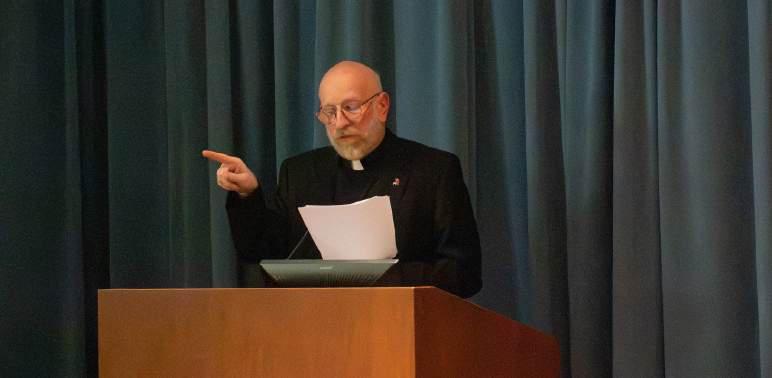
wide range of social goods that define our lives, including material wealth and income, but also less tangible goods, such as social status, personal recognition and opportunities for advancement,” Massaro said.
Massaro further described meritocracy as a system that perpetuates a divide between the “winners” and the “losers.” He cited the arguments of philosophers and sociologists like Michael Young and Michael Sandel, both authors of books on the notion of meritocracy.
“‘By justifying a narrow measure of merit and bestowing outsized rewards on people possessing only certain skills, a meritocratic system tends to foster great hubris in the winners and extreme humiliation among the losers,’” Massaro said, quoting Michael Sandel’s book “The
Tyranny of Merit: What’s Become of the Common Good?”
Massaro expanded on this idea, explaining how winners’ egos inflate as they bathe in the benefits of the “diploma divide” and losers feel the “brunt of harsh, moral judgmentalism.”
His respondent, Bogia, countered that it can be fair for winners to feel hubris if meritocracy lived up to its promises of equal opportunity.
“The ideal of meritocracy survives this reality if it limits its promise to input. That is, to equal opportunity, not equal outcomes,” Bogia said.
Bogia concurred that meritocracy can — and will — continue to exist within American society.
“Liberal advocacy for a view such as this one underscores that meritocracy need not be our primary organizing principle,
economically or culturally, without having to abandon the premise entirely,” Bogia said.
Massaro emphasized individual moral responsibility to reform systems that violate human dignity.
“We all have a solemn obligation to resist the mechanisms that exclude and stigmatize our brothers and sisters, and which are inconsistent with the values of human compassion, fairness, inclusivity and neighbor regard,” Massaro said.
When asked about the relevance of understanding meritocracy in the modern day, Massaro noted that it is extremely important as income inequality becomes more severe and pervasive.
“The rich are getting richer (and) the poor are getting poorer,” Massaro said. “So this topic, for me, captures the moral imperative.”
Massaro also believes it is crucial for younger generations, especially college students facing the hurdles of the job market, to critically reflect on the practical reality of meritocracy in America will affect their futures.
“Opportunities are more closely attached to credentials. In my time, you could make up for the lack of a master’s degree by doing something else or having some skill that you could demonstrate,” Massaro said. “I think that’s less likely now, so college admissions become more prioritized, or heightened. So you’re going to have to fight.”
The proceedings ended in a 15-minute question-and-answer session, where Massaro and Bogia answered questions from the audience about topics like meritocracy in college admissions, AI and religious life.
To close the lecture, Massaro highlighted the question he believes his audience should be asking themselves after they leave the auditorium doors.
“In whom are we willing to invest public resources, private resources (and) opportunities? Yeah, we can’t guarantee outcomes; we can’t even guarantee the quality of opportunity. It’s a complex world; there’s a lot of injustice out there, and the starting points are staggered,” Massaro said. “But if we’re willing to invest in people, both monetarily and (with) advice, or even a good kindly counselor (that) can steer you in the right direction. That counts.”
The information for the next McGinley lecture of the 202526 academic year has yet to be announced.
ANDREW MADROWSKI/THE OBSERVER
COVID, flu and strep tests.
GRACE SANTOLI/THE OBSERVER
Thomas Massaro, Jesuit priest and professor of moral theology, delivered a lecture on the ethics of meritocracy.
Changes Made to Pre-Professional Advising
With the elimination of former Assistant Dean of Pre-Law Advising Hillary Mantis’ position, the pre-law advising program will see significant changes
ADVISING from page 1
The pre-health program’s offerings are comprised of a symposium, peer mentorship, connecting students to experiential learning opportunities like clinical experience and research, and personalized advising. The Fordham College at Lincoln Center (FCLC) Committee on Health Professions is another part of the program and works with upperclassmen and alumni for several months on their medical school applications, which require a committee letter of recommendation. Martin di Grandi is the prelaw advisor for FCRH and Laura Bigaouette is the interim program director and pre-health advisor for FCLC. As of yet, no further personnel and structural changes have been announced to the program, beyond the oversight of the new assistant dean for pre-professional advising.
“ No one had told us and informed us that the prelaw advising program was over or that the dean was fired, so we were a bit shocked and we didn't know where to go from there. ”
Alyssa Hurtado, President of the pre-law society
The dean’s responsibilities will include advising students on course selection and requirements, aiding with applications and test preparation for professional schools, organizing and leading informational sessions and collaborating with Fordham staff, student organizations and professional schools to facilitate networking and experiential learning opportunities.
Petra also wrote that the dean will also focus on supporting “diverse student populations, including underrepresented and first-generation college students.”
Per student need, pre-professional advising may expand to include other pre-professional tracks and accelerated master’s programs.
“This position will be situated in the FCRH and FCLC Dean’s Offices working directly with undergraduates; we will absolutely be able to provide guidance
on professional paths across disciplines,” Petra said.
These changes, in particular Mantis’ departure from Fordham, caused some initial confusion for some pre-law students, who mistakenly thought the pre-law advising program itself had been terminated.
Alyssa Hurtado, president of the pre-law society and FCLC ’27, expressed her frustration and said that “(the pre-law society) was kind of left in the dark.”
“No one had told us and informed us that the pre-law advising program was over or that the dean was fired, so we were a bit shocked and we didn’t know where to go from there,” Hurtado said. “I feel like someone else from Fordham should have informed us.”
FCLC’s Pre-Law Society had been in contact with Mantis on Aug. 27 when Mantis confirmed she would attend their first event of the year — Cupcakes with Dean Mantis — which was a recurring tradition of the club. The event was scheduled for Sept. 4, but did not end up happening.
The club emailed Mantis for clarification on the event and received an automatic response that read: “Hillary Mantis is no longer with Academic Advising. Please contact the FCRH Dean’s Office, rhdean@fordham.edu, for assistance with student or pre-law matters.”
Hurtado also expressed her concern that the current absence of the expertise of a specific prelaw advisor may disproportionately affect underclassmen.
“I think it would affect more the underclassmen who had just come in and don't know anything about the programs we offer or the guidance on how to apply to law school,” Hurtado said. “I feel like if students were looking for a change, it would have been a more focused pre-law course … I feel like this change has become more distant from a focused prelaw course.”
Fordham still has a lawyer and other professionals with relevant pre-law experience on the advising staff, according to Petra.
As for the elimination of Dean Mantis’ role, Robert K. Moniot, associate dean for undergraduate education and supervisor of the pre-law advising program, said he believes Mantis is eligible to apply for the assistant dean for pre-professional advising position but confirmed that, as of now, she is no longer with academic advising.
“I believe (Mantis) has the option to apply for this new

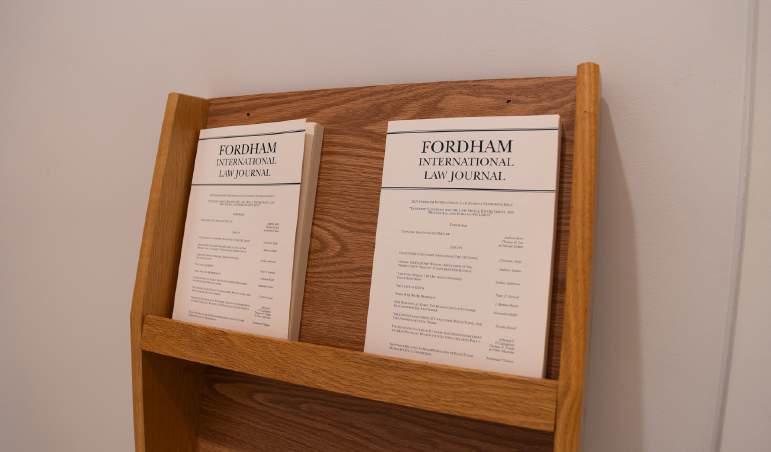
position, but if she does get hired for that, it would be an expanded role,” Moniot said. “I’m sure it’s difficult for these upper administrators to have to make these decisions that affect people’s careers. They’re doing it to try to make the administrative structure function the best to serve our students.”
Petra situated all of these changes within the broader administrative restructuring that took place over the last couple of years, and specifically this summer.
“The process of reorganizing the overall advising structure in Arts & Sciences began last year as the transition to a new leadership structure was also underway,”
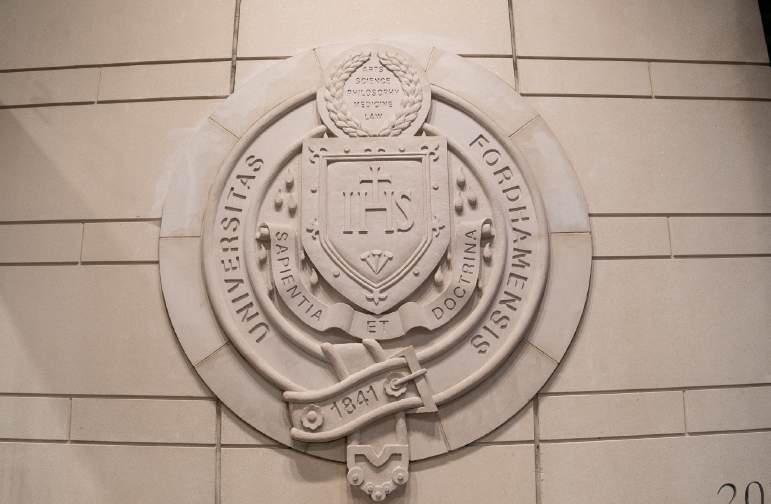
Petra said. Starting last fall, the University began a search for a dean of arts and sciences that concluded with the hiring of Jessica Lang, who began working in an official capacity on July 1. With the hiring of Dean Lang, Fordham now has one dean of arts and sciences and three vice deans: Rachel Annunziato, vice dean for undergraduate education; Ann Gaylin, vice dean for graduate education; and Robert Hume, vice dean for faculty. According to Moniot, Gaylin’s and Hume’s responsibilities are very similar to their jobs before, but they now report to Dean Lang rather than to the provost.
“ The process of reorganizing the overall advising structure in Arts & Sciences began last year as the transition to a new leadership structure was also underway. ”
Jennifer Petra, Media and public relations
While Moniot was not directly involved with the restructuring process, he shared a similar perspective on the reasons behind the decision to restructure the School of Arts and Sciences as being toward streamlining efficiency. Before, the four deans would have to get together and agree on hiring new Arts and Sciences faculty and other decisions, which Moniot said
was logistically complicated.
“Fewer cooks make the kitchen function better,” Moniot said. The College of Arts and Sciences at FCLC and FCRH are now being supervised by new Senior Associate Deans Daniel Ott and Dave Swinarski, respectively.
“ Fewer cooks make the kitchen function better. ”
Prior to this, the arts and sciences colleges at Fordham were run by four deans: the dean of FCRH, the dean of FCLC, the dean of the Graduate School of Arts and Sciences and the dean of faculty.
Moniot also mentioned the changes to Fordham’s general advising. In the last few years, Fordham has switched from a faculty advising model to having students be guided through their core and major requirements for their first two years by professional advisors, and working in tandem with a faculty mentor pertaining to their major for their final two years. Faculty advisors serve as mentors, providing guidance on professional opportunities and graduate school applications.
Thus, Moniot said, the changes to pre-law advising are “all within the context (of) — well, related to — the larger picture of the restructuring of Arts and Sciences” in terms of increasing efficiency. The new assistant dean for pre-professional advising will be integrated shortly, and further developments are likely as the new academic year progresses.
GRACE SANTOLI/THE OBSERVER
Fordham has a variety of programs and resources for pre-law students, including the Pre-Law Society, 3-3 program and Fordham Lincoln Center Mock Trial.
Fordham’s undergraduate colleges are one of the top feeders to the Fordham Law School.
Robert K. Moniot, Assoc. dean of undergrad education
The Rise of Conservatism
How influencers like Charlie Kirk and Nara Smith have influenced Gen Z into becoming more conservative
By MACKENZIE COOPER News Editor
Conservatism is on the rise among Gen Z, and Fordham students are growing increasingly aware of this phenomenon.
Conservatism in the United States is deeply rooted in the belief that the interpretation of the Constitution must be based on the authors’ intent and preserving those traditions amidst societal changes over time.
The conversation around conservatism on campus has recently grown more relevant. Charlie Kirk, founder of Turning Point USA, a nonprofit organization that advocates for conservative politics on high school, college and university campuses, was assassinated on Sept. 10 at Utah Valley University.
“ It’s worth it to have a cost of, unfortunately, some gun deaths every single year, so that we can have the Second Amendment to protect our other God-given rights … That is a prudent deal.”
Charlie Kirk, Former CEO of Turning Point USA
At the age of 18, Kirk started his own grassroots organization in his small suburban hometown outside of Chicago. His efforts later grew into what we now know as Turning Point USA. Kirk dropped out of college after one semester and never received a college degree. He became the youngest speaker at the Republican National Convention in 2016 at the age of 22.
What made Kirk extremely popular on social media were his debates in which he visited different colleges and invited students to argue with him at his coined “Prove Me Wrong” table. Kirk and his organization Turning Point USA were influential in spreading conservative ideas across college campuses. According to the Turning Point USA Students website, the organization has over 800 chapters around the country. Currently, Fordham does not have an official chapter on either campus.
One of Kirk’s most controversial takes was on gun control policies in the United States, as he viewed gun deaths as a worthy risk in order for the Second Amendment to be protected. During an April 2023 visit to the Awaken Church in Salt Lake City, Utah, Kirk said, “It’s worth it to have a cost of, unfortunately, some gun deaths
every single year, so that we can have the Second Amendment to protect our other God-given rights … That is a prudent deal.”
Because Kirk had strong conservative beliefs in regards to abortions, DEI, LGBTQ+ rights and gun control, he appealed to conservative Americans who feared liberal policies would violate traditional American values.
“What we believe as conservatives is that skin color really doesn’t matter that much. We care about character and merit. We want a country built on what you bring to the table, not how you look,” Kirk said.
Pietro Bovari, Gabelli School of Business at Lincoln Center ’26, is an international student from Italy who has seen the effects that Kirk has had on the younger generation and why Kirk may be desirable, especially to younger men.
“I feel like as a society, everybody wants to hear what they think is right and therefore there’s been a shift to either side. There’s less communication and more, ‘Oh, I’m right because he said so,’” Bovari said.
In 2023, The Wall Street Journal published a video with statistics on why young men are turning to the Republican Party. From 2016 to 2023, there was a 13% increase in the number of young American men ages 18 to 29 whose party preference was the Republican Party.
“ I feel like as a society, everybody wants to hear what they think is right and therefore there’s been a shift to either side. There’s less communication and more, ‘Oh, I’m right because he said so.’”
Pietro Bovari, GSBLC ’26
Social media has been influential in the rise of conservatism among young women in the U.S.
The following of young female conservative influencers who have taken to their social accounts to post their lifestyles has increased.
Using social media platforms like TikTok and Instagram, influencers like Hannah Neeleman, better known as Ballerina Farm, and Nara Smith, who is known for her traditional style and “tradwife” content, are paving the way for Gen Z conservative ways of living.
According to an article by Vogue Business, in 2024, Smith’s
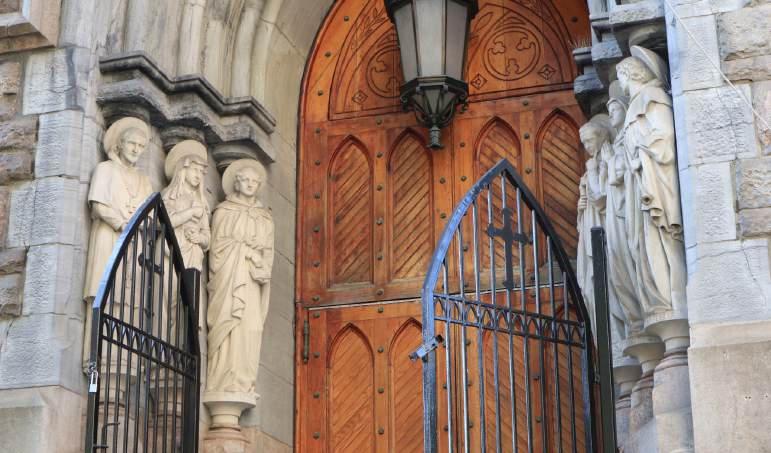
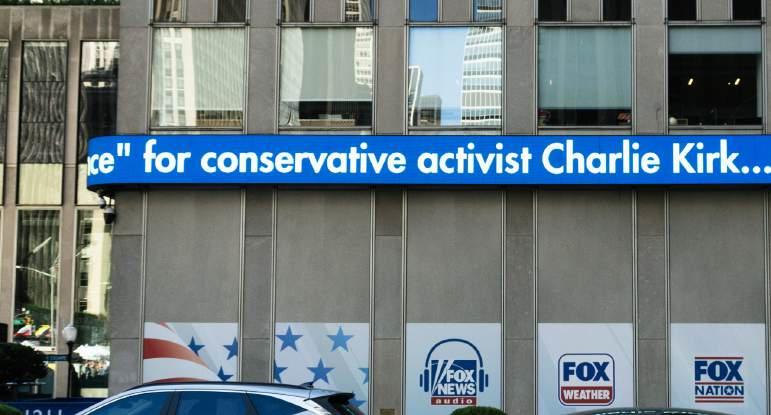
social accounts grew: “(Smith’s) TikTok followers are up 700 per cent since 9 January, and Instagram is up 670 per cent.”
Tanaya Barnes, Fordham College at Lincoln Center (FCLC) ’28, is well aware of influencers like Smith who use their brands to promote new forms of conservative lifestyles to Gen Z. Barnes mentioned that these influencers rely heavily on social media to promote a modern conservative life to their audiences.
Barnes said that she thought these influencers “made conservatism into an actually desirable brand.”
The term “tradwife,” an abbreviated version of “traditional wife,” has been thrown around with reference to influencers like Smith and Neeleman. The Merriam-Webster definition of the term refers to “a married woman who embraces traditional gender roles and values; the word is particularly

used for a young woman who chooses to be a homemaker and shares her lifestyle online.”
Barnes touched on how Smith and Neeleman have restored the traditional stereotype of what a woman should act and look like.
“She is really what women are ‘supposed’ to be like — she just stays home and does nothing, and that’s becoming desirable for young women because young women are like, ‘Oh, well, she’s rich and she doesn’t have to do anything,’” Barnes said. “That plays into how overarching capitalism is, because we don’t want to go to work, and that’s why people are finding a new solution.”
“ The basis of conservatism is a desire for less government interference or less centralized authority or more individual freedom. ”
Ronald Reagan, 40th U.S. President
Conservatism became prevalent after WWI, but saw substantial growth during the 1970s and 80s. Americans grew dissatisfied with left-leaning policies, while government distrust grew as a result of the Vietnam War and Watergate. Alongside an increasing struggle with economic instability, Americans found their way back to traditional values.
In a 1975 interview with Reason Magazine, before becoming president, then-California Governor Ronald Reagan presented his idea on why conservatism was on the
rise in the U.S.
“The basis of conservatism is a desire for less government interference or less centralized authority or more individual freedom,” Reagan said.
Reagan had a strong role in shaping conservatism during this time, advocating for legislation on the issues of religion in schools and limiting abortion. He appealed to conservative Americans by promoting traditional family values in his presidential actions.
Though associated with the Republican Party, conservatism is present in the Democratic Party as well.
The Blue Dog Coalition is a caucus within the United States House of Representatives that was founded in 1995 by conservative Democrats. It remains the most conservative group within the Democratic Party. Historically, they have been fiscally and socially conservative, but today, they are described as socially liberal and fiscally conservative.
Charlie Kirk’s funeral was held on Sept. 21 at the State Farm Stadium in Glendale, Arizona. Included in the 90,000 people in attendance were President Donald Trump, Tucker Carlson and Elon Musk.
Erika Kirk, Charlie Kirk’s widow, who spoke at her husband’s funeral, has vowed to take over her husband’s company, carrying on its mission of spreading conservatism among institutions across the country.
After the death of Kirk, college students across the country have turned to public discourse on political violence. The division between the Republican Party and the people’s definitions of conservatism are expanding, leading to the possibility of convergence to be unknown.
SAMANTHA GEILER/THE OBSERVER
Conservatism has always had a strong affiliation with religion.
MACKENZIE COOPERI/THE OBSERVER
Charlie Kirk was the youngest speaker at the Republican National Convention in 2016 at the age of 22.
GRACE SANTOLI/THE OBSERVER
Conservatism is a cultural, social and political philosophy and ideology that promotes and preserves traditional values.
By FEHINTOLA TAIWO
Contributing Writer
BSA Hosts Annual Fall Cookout
Fordham Lincoln Center’s Black Student Alliance “kicks off” the semester by celebrating a large part of Black culture
On Sept. 20, new and returning students gathered on McMahon Lawn for Fordham Lincoln Center’s Black Student Alliance (BSA) annual cookout. Following the success of last year’s event, the yearly cookout gives undergraduate students the opportunity to celebrate this important piece of Black culture through music, games and food.
Karina Ruiz, Fordham College at Lincoln Center (FCLC) ’26, and director of public relations for BSA, commented on the significance of a cookout.
“We love to do a cookout because we find that a gathering that’s outside with games surrounded by music and food is just an essential part of Black culture … Around the whole Black diaspora, we all have aspects of cookout culture within our own specific communities,” Ruiz said.
“ Finding a Black community at a PWI (predominantly white institution), I just feel at home. ”
Tallulah Rudasingwa, FCLC ’28
BSA’s cookout is an example of one of the ways Black people around the world show up for each other and reconnect. Tallulah Rudasingwa, FCLC ’28, expressed that holding this event at Fordham gives students a safe space to connect with others
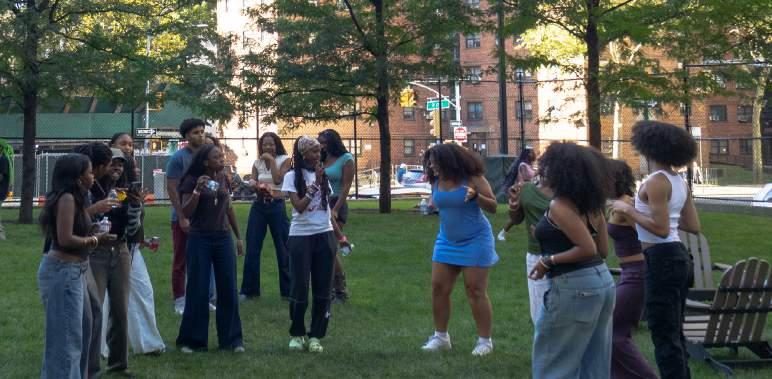
BSA hosts events throughout the year that are centered around community-building.
from similar backgrounds and share their culture with people who are curious about it. This was their first time attending the annual cookout.
“Finding a Black community at a PWI (predominantly white institution), I just feel at home,” Rudasingwa said. “Finding people who look like you, I feel like it just feels very comforting, especially since I went to a high school that was predominantly Black.”
Toni Akinbamowo, secretary of BSA and FCLC ’26, emphasized the importance of having the event at the beginning of the school year.
“We do a fall cookout to start the semester off on a good note,” Akinbamowo said. “Fordham can be a little bit of a grind … it’s great to start it off with a little bit of fun and community.”
The event curated a cultural experience that included soul food — catered by Charlie’s Pan
Fried Chicken this year — music that ranged from afrobeats to R&B and various games such as UNO and other tabletop games, pickleball, volleyball and hula hooping.
Roslyn Mensah, FCLC ’27, who has been an active member of BSA since her first year at Fordham, complimented the overall ambiance of the event.
“I really like the music and that there’s games. It’s a chill event to start the year,” Mensah said.
Mensah, reflecting on her experience with BSA as a whole, said that the club makes it “so much easier to meet people, especially at Lincoln Center … It’s just an open and free space to talk about anything that’s bothering you.”
Courton Johnson, FCLC ’29, who grew up in Jamaica, said he enjoyed the cultural experience he gained from this event.
“I needed some reinforcement
culturally, and this was that,” Johnson said.
BSA hosts events throughout the year that range from game nights to career-building and connecting with alumni. Jillian Bruno, president of BSA and FCLC ’26, hopes to also make time for fun.
“I’ve loved BSA every single year I’ve been in it,” Bruno said. “I think we’re excited to really have fun with it and do even more community-building things. I love how much education we focus on — we have a lot of alumni connections, which I love, but I just want us to play together and have everyone feel like they’re friends … I’m excited for everyone to get really close.”
Bruno said she is most excited for BSA’s Black History Month events. The club kicks off the month of February with a small party or “social,” and then the month is filled with dinners,
Saxbys Opens Oct. 1
guest speakers and “chats” where members are given a topic and encouraged to engage in casual conversation with each other. Bruno discussed how important and busy the month of February is for BSA.
“Black History Month in February is huge for us. We have so many alumni come in,” Bruno said. “I love the art showcases that we do. I feel like everyone in this club is so creative.”
“ I needed some reinforcement culturally, and this was that. ”
Courton Johnson, FCLC ’29
BSA’s E-board highlighted the importance of encouraging connections with alumni in hopes of fostering an environment where alumni feel welcomed to join in and help with future events.
Jemima Monga, a Gabelli School of Business alumna who goes by the stage name “Ms. Worldwide,” is one such example. She returned to DJ the cookout again for the second time after having graduated last year. Monga’s set included staples of cookout songs such as “Wobble,” “Cha-cha slide” and “Candy,” bringing people together to line dance in between bites of soul food and a game of Jenga.
BSA meets every Monday at 5:30 p.m. in the Leon Lowenstein Center in room 710 and can be found on Instagram @bsa_lc. Their next large-scale event will be their Halloween mixer on Oct. 30.
The new student-run cafe is getting ready to be part of the Fordham community
SAXBYS from page 1
Aidan Engelmann, Gabelli School of Business (GSBLC) ’26, is the current SCEO of Fordham Lincoln Center’s Saxbys. Engelmann credited Costello, Saxbys headquarters and Fordham as a “constant support system” throughout the cafe’s development. For Engelmann, Saxbys offers students more than “just a job.”
“It’s a community first and foremost,” Engelmann said. “On top of that, it’s a learning platform … that can really teach all of the team members … new things that they might not have experienced before and give them kind of hands-on experience in the real world.”
“ It’s a community first and foremost.”
Aidan Engelmann, SCEO of Fordham Saxbys
Many Fordham Lincoln Center students have indicated regret towards the dispersion of the former Argo employees. However, Engelmann reassured that they are “thankfully still … on campus,” and expressed excitement for introducing the Saxbys spirit to campus.
“I know Argo had a great community,” Engelmann said. “But I also know that having students behind the bar — people that you’re friends with, people that you see on the day to day in classes … creates a lot more of a

GRACE SANTOLI/THE OBSERVER
Lincoln Center’s Student Cafe Executive Officer Aidan Engelmann, GSBLC ’26, is excited to lead the Saxbys team.
campus feel.”
The Saxbys team also expressed excitement for bringing a wide array of menu options to Fordham Lincoln Center students.
Just in time for fall, the Saxbys team is preparing their housemade pumpkin flavor for students to give their drinks an autumnal quality. Costello explained that, while other coffee houses may use “watery” syrups, their recipe is derived from “pumpkin puree,” creating a “thick” and more natural drink flavoring. Keeping their drinks natural for students is important to Saxbys, as they do not add any extra sweeteners.
The “Fit FroLatte” is also unique to Saxbys. A specialty cold
coffee, Costello described it as a “smooth, thick, smoothie-type of cold brew.” Cruz recommended the matcha version of the “Fit Frolatte,” predicting that, if students add their house-made pumpkin flavor, it would be an especially popular menu item.
Camille Beaufort, GSBLC ’29, attended Engelmann’s presentation on Saxbys. Beaufort expressed her enthusiasm for Engelmann’s potential as a leader, and she is “sure (Saxbys) is going to be a big hit on campus.”
“I think he’s very well spoken … I’m very happy that it’s student-run. I feel like it makes me want to go there more,” Beaufort said. “Especially in business,
everyone is kind of sharks … so I think he’s doing great.”
While first-year students are excited about Saxbys, older FCLC students have expressed grief over the sudden closing of Argo. Dany Wilson, FCLC ’26, described how the switch came “as a shock” and wished that the student body had been given more context.
“A lot of students who built rapport with those workers in Argo have to now experience something different … combined with the fact that we’re almost two months into the semester and Saxbys isn’t even done yet — stuff like that has a lot of people skeptical about how it’s going to run,” Wilson said.
When Saxbys was first
announced to replace Argo Tea in mid February, the opening had been advertised as September. The unfinished status of the cafe throughout this month has left students puzzled, but Orla Fitzsimons, director of dining business operations and contract management, claimed that opening in October “had been part of the planning timeline for some time.”
“ I think he’s very well spoken … I’m very happy that it’s studentrun. I feel like it makes me want to go there more.”
Dany Wilson, FCLC ’26
“As Argo Tea continued operating through the spring semester 2025, all teams were focused on ensuring a smooth and timely transition,” Fitzsimons said.
Fitzsimons expressed her and the United Student Government’s approval of the Saxbys partnership, explaining that it “enhances both the academic and culinary options” at Fordham.
The Saxbys at Fordham Lincoln Center will operate Monday through Thursday from 8 a.m. to 10 p.m., on Friday from 8 a.m. to 3 p.m. and on Saturday from 3 p.m. to 10 p.m. The cafe will be closed on Sundays, and modify their hours during breaks.
COURTESY OF BLACK STUDENT ALLIANCE
Sports & Health
A Blanket for the Mind in a Restless Age
With depression on the rise in the US, can one find mental comfort in creating a narrative?
By JACK BRUDECKI Fact Checker
This past April, the Center for Disease Control (CDC) published a statement highlighting reports on an increase of depression among Americans. According to the CDC’s National Health and Nutrition Examination Survey report, “the prevalence of depression in U.S. adolescents and adults increased 60% in the past decade.”
Furthermore, a perhaps even more troubling statistic from the report finds that a staggering 87.9% of individuals with depression “reported difficulty with work, home, or social activities because of their depression symptoms.” In short, not only is depression increasingly prevalent in the United States, but depression appears to greatly harm individuals as they try to keep up with their responsibilities and interests.
I
find it necessary to emphasize the importance of mental health because of its relation to the overall health of one’s body. As an example, the National Institute of Mental Health, a federal agency within the Department of Health and Human Services, observed that individuals with depression are at increased risk of developing chronic diseases like heart disease or diabetes. Additionally, there exists present discourse surrounding concepts of psychosomatic disorders, a category describing physical — somatic — symptoms caused by mental stress. It is clear that the increased prevalence of
depression has implications for the overall health of many individuals, and as such, demands our attention if we wish to be healthy in a holistic sense.
But how does mental health as a concept fit in with overall health? It turns out the answer is not as clear as one would initially think. In their 2023 study of different theoretical models for mental health, scholars Dirk Richter and Jeremy Dixon said that they were “unable to detect any approaches which might act as a basis for consensus within the academic field, amongst clinical professions, or between stakeholders.” In short, the definition of mental health is anything but clear-cut.
Another study, by researchers Jesse S. Y. Tse and Nick Haslam, found “the public’s concept of (mental health disorders) is not in lockstep with organized psychiatry,” highlighting definitional disputes present not only among clinicians, but between institutional views and those of laypeople. All this is to say that these disputes about the way we define mental illness — and its causality — create a vacuous space in which a pluralist approach to health can take shape.
For example, scholar Dennis Patrick Slattery examined the ways in which psychology can be viewed as a matter of poetics and mythmaking rather than only a scientific field. Slattery writes about “Re-visioning Psychology,” a book by American psychologist and scholar James Hillman. According to Slattery, Hillman aims “to realign the
work of psychology — the logos of the soul — with the imagination.” This goal is also reflected in Richter and Dixon’s overview, as they write, “the domain of mental health problems is no longer viewed as exclusively psychiatric or psychological.”
I have chosen to present Slattery’s work because I feel that one can all too often reduce mental health to a purely scientific domain. Instead, I would like to explore how psychology can relate to creative endeavors that engage more with one’s imaginative abilities rather than one’s rationality and logic. Is mental health less about diagnostic discoveries and more concerned with the production of narrative?
In other words, is taking care of one’s mental health like writing a novel?
On this last point specifically, I refer back to Slattery. He claims that “(mental) pathology is less organized around literal events, sicknesses, excesses, natural events, and more deeply around ‘mythical figures.’” In other words, our views of events in our lives are constituted more by our own imaginative description rather than the objective, observed actuality. Our lives become how we perceive them as opposed to matters of fact.
As bold an assertion as this may be, I think there exists something to gain in indulging this view and engaging with creativity when exploring subjects one may initially view as set in stone. More specifically, I wish to explore the innumerable ways in which our psychic lives are affected by the

activities we take part in, the beliefs we hold dear and the narratives we thereby create for ourselves.
Like Slattery, I am positing a return to analogy as a method for self-description. By virtue of this expanded scope (as individuals can form an infinite amount of analogies, so the limit of the method is by definition inestimable), the mental life is adjacent to the political, social, spiritual and intellectual lives of an individual, blurring clearly observed boundaries between these categories.
Pushing further down this path, what does it mean to conceive of psychological care as a form of prayer and communion?
El Orgullo de México Ya No Es The Pride of Mexico Is No More
As an investigatory mythmaking? Through writing, that delicate form of self-exposure? As an absence, a letting-go of the ideas and conditions with which one is constricted?
These are the questions I intend to explore in closer detail as to provide a greater sense of comfort alongside a healthy mind. My hope is for this ever-expanding amalgam of ideas to form a tapestry with which we can cover ourselves. It is not that one section of this quilt should take precedence over others; it is precisely because one combines these wonderfully varied components together that any of them can be individually effective.
Canelo Álvarez’s loss poses more questions for the future of Mexican sports
By JOHN GARZA Contributing Writer
Mexican boxer Saúl “Canelo” Álvarez suffered a major loss on Sept. 13 in a fight against American boxer Terrance Crawford. The fight was viewed by more than 41 million people on Netflix, but was void of any moments of true action.
Although Canelo is considered the star of Mexico, Crawford outpaced him and dodged what felt like nearly all of his punches. At times, it looked as if Crawford was avoiding any confrontation by running back and avoiding the aggressor.
The victory for Crawford was a unanimous decision and elevated his legacy from an already great fighter to a household name in boxing. Canelo’s loss was a loss for many, including Alondra Gonzalez, Fordham College at Lincoln Center ’26. Gonzalez is from Canelo’s hometown of Guadalajara and was “crushed” as she knows the significance of the “idol of Canelo”’s origins: a true rags-to-riches story.
Canelo’s boxing story started when he was a child, selling popsicles on the streets and buses of Guadalajara, Jalisco. He would use all his extra funds to purchase boxing equipment in the hopes of following his older brothers’ footsteps in the sport. Thus began Canelo’s boxing career, which kept him off the streets as he became the champion he is now recognized as.
Calls for Canelo’s retirement have increased. In his performance
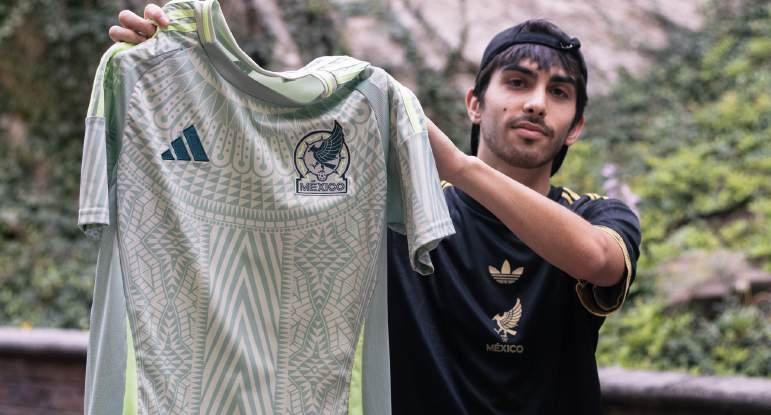
on Sept. 13, it seemed like Crawford was simply too quick for the typically technical and speedy Canelo. The loss was a hard pill to swallow as Canelo has been the face of Mexican boxing since his Las Vegas debut in 2010. If Canelo were to retire, it would cause a massive blow to the nation’s athletic standing.
The question that arises is:
What will Mexican sports look like in the future?
The sports market within Mexico is massive: Its revenue is almost $1.3 billion, according to Statista, but most of this money is paid to outside sports markets like the NFL and NBA. This is part of a
larger trend in sports where comparatively smaller markets siphon off the already curated fanbases of larger markets — such as that of the U.S., England and Germany — to generate profit for broadcasting companies, while depriving locals of their own national sports content.
There is some competition in the national and international sports markets with Mexico’s national soccer league Liga MX, but it does not compare to its European equivalent.
Must Mexican sports fans hope for a breakout star to emerge in a sport unconventional for the country, such as American
football, basketball or baseball?
Gonzalez feels that sports themselves are going through a sort of revolution, with previously obscure ones such as “rock climbing and everything (becoming) a little bit more popular.” In regard to Mexican sports, she thinks that “people are going to start turning to look that way, and they’ll like sports that aren’t necessarily like soccer.”
There are many paths through which Mexican sports could possibly gain more world recognition, but there is one glaring option in the country’s face: boxing.
Canelo is a successor in a line
of great Mexican boxers that have been churned out in the past 50 years, with names like Oscar de la Hoya, Julio César Chávez and his son Chávez Jr. becoming generational greats. However, Mexico has no national or state-level boxing programs for talented youth like it does for soccer. Mexico could construct several national gyms and employ the coaching staff of these great boxers in the hopes of encouraging a number of the youth, priming them for stardom.
For Mexicans, there is a great joy in putting one’s hope behind a team with a love and history that can be passed down from generation to generation, and boxing simply can not provide that. The inherently individualistic sport of boxing conflicts with Mexicans’ passion for community and continuity. Once a boxer retires, the love and hope once put in them retires with them.
Mexico has climbed to the highest ranks of boxing, but it has only been thanks to the global growth of the sport that a breakout star like Canelo has been able to penetrate the American market.
While it is yet to be seen whether the 35-year-old fighter will retire anytime soon, it is fair to say that his career is much closer to its end than its beginning. One can only hope that this will reinvigorate the sports world in Mexico to find a new set of stars to take over and give Mexicans everywhere someone they can call their champion.
KEI SUGAE/THE OBSERVER
Saúl “Canelo” Álvarez is a legend in his hometown of Guadalajara.
GRACE SANTOLI/THE OBSERVER
More and more Americans are searching for therapeutic comfort in a variety of places.
College Athletics: A Career or a Brand?
What do we make of Fordham Athletes after the House v. NCAA settlement?
At Fordham, that shift took shape in September when the university announced the hiring of Danny Enjamio as its first general manager for NIL licensing. His position, created specifically in response to the new environment, will oversee all NIL-related activities for student-athletes, using the platform Opendorse as a central tool.
Not only will former athletes be compensated for the years they were barred from NIL opportunities, but schools can now pay their athletes directly.
Enjamio brings a hybrid background: law school at the University of Florida, litigation experience at Carlton Fields and a stint on the basketball operations staff at George Washington University. That combination of legal and athletic knowledge makes him uniquely suited to guide Fordham athletes through contracts, compliance and marketing opportunities.
“
Atlantic 10
schools would need to begin taking part in revenue sharing and NIL to compete.”
In practice, his job will involve everything from ensuring athletes understand endorsement agreements to helping them explore ways to connect with businesses and brands. In a city like New York, where the competition for visibility is intense but the opportunities are vast, his role could be transformative.
Jay Paterno, former NCAA Division I football coach, former recruiting coordinator, author and speaker commented on a financial strain possibly facing smaller Division I schools such as Fordham.
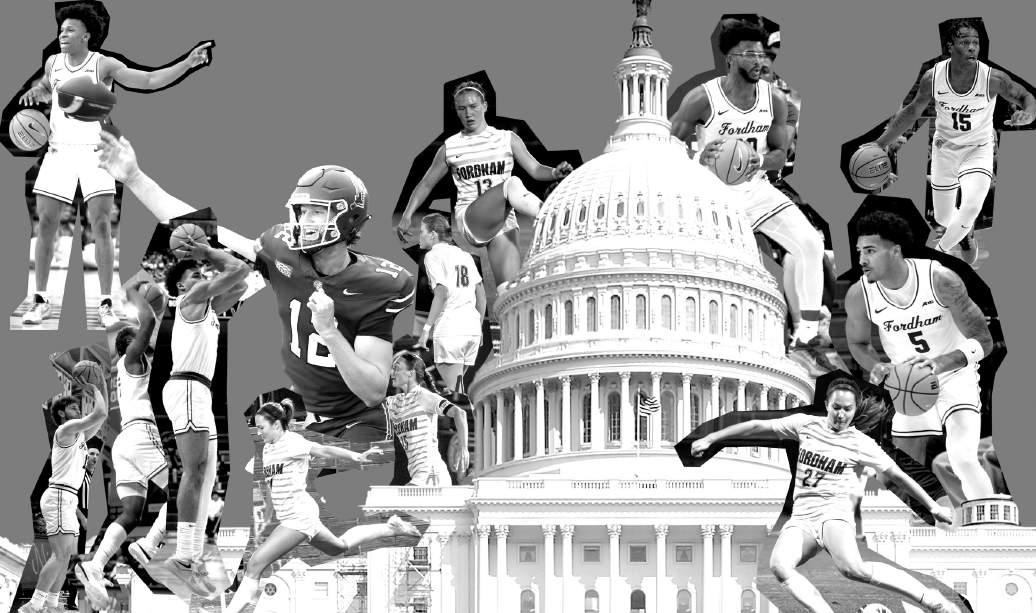
“Even the highest-revenue (Division I) schools will have to find ways to fund the revenue sharing and the NIL settlement money and new scholarships if the limits are lifted. Non-Power-4 (Division I) schools will have to look at cost efficiencies and have to prioritize certain sports,” Paterno said. “Atlantic 10 schools would need to begin taking part in revenue sharing and NIL to compete.”
Paterno’s comments explicitly convey that the settlement marks the end of college sports as amateur and begins its journey towards a more serious, professional athlete program.
The House settlement has not altered much within the athletic department so far.
While administrative hires and billion-dollar settlements make headlines, the real impact is felt in locker rooms and classrooms.
Vinny Rugai, Fordham College at Rose Hill ’27, is a running back on the football team studying
finance. He has yet to see the impact of the settlement in his day-to-day life.
“Honestly, no, I’m not noticing any changes on our team,” Rugai said. “Our guys are a good group of guys. We do have one of the bigger teams here with over 100 guys, but I’ve not noticed any changes.”
Rugai also noted that while Fordham has a new athletic director this year, the House settlement has not altered much within the athletic department so far.
Football is often singled out as the biggest benefactor of NIL because of its revenue-generating power. But Rugai was quick to point out the differences between levels of college football.
“Yes, football teams are the biggest benefactors due to revenue sharing,” he said. “At the FCS level, which we are in, that trickles down less compared to the bigger FBS schools, where there’s just more money involved in those programs.”
For athletes in Rugai’s position, NIL may not mean seven-figure shoe deals, but it could still help cover living expenses, build connections and provide real-world experience. And for
a finance student, the overlap between classroom knowledge and business opportunities could be especially valuable.
“ I definitely think there is an opportunity for athletes to act as entrepreneurs ... You can market yourself as a brand, put yourself out there to different companies … and create leverage for yourself to make money.”
“I definitely think there is an opportunity for athletes to act as entrepreneurs,” he said. “You can market yourself as a brand, put yourself out there to different companies … and create leverage for yourself to make money.”
Rugai understands that change
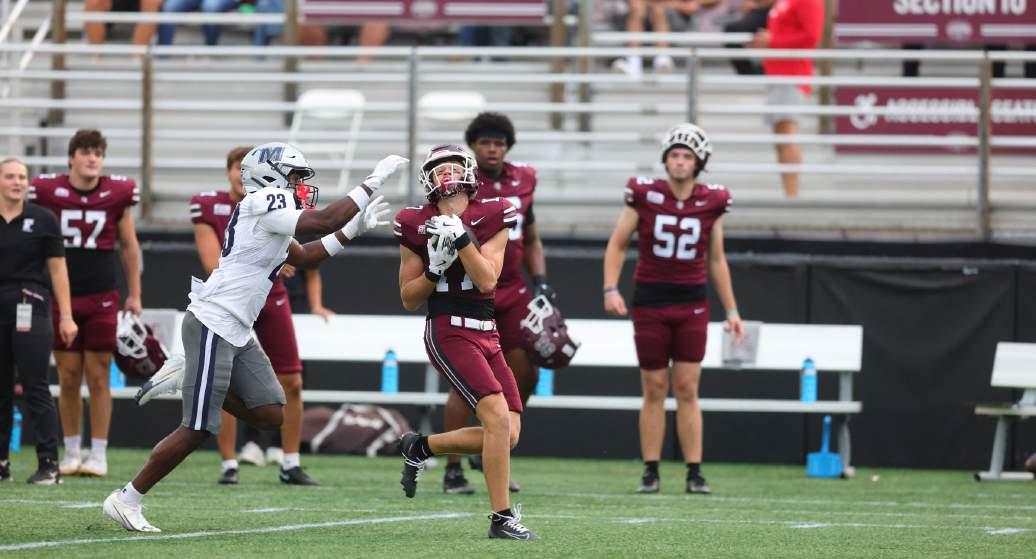
will be instituted progressively, both in college athletics and at Fordham.
“The house itself will continue to oversee the process, and maybe even create more laws to just regulate even more. We saw it like this week that they just made it so the transfer portal window in the spring closes,” he said.
The question — “career or brand?” — continues to linger. For some athletes, especially those in Power Five conferences, NIL may be a stepping stone to professional sports. But for many, including Patriot League players, the chance to develop a personal brand could outlast their athletic careers. However, Rugai continues to worry about the life-altering decisions that young athletes will be making.
“These are 18 to 23-year-olds. Obviously, they’re adults, but they shouldn’t be making decisions … just based on a couple hundred thousand or maybe a million dollars,” Rugai said. “You go to school to learn and create a base for the next four years.”
Whether college sports are now more of a career or a brand may depend on the individual athlete.
Whether college sports are now more of a career or a brand may depend on the individual athlete. But what is clear is that the change is incoming; as new students commit to Fordham and sponsorship opportunities increase, a bright future awaits the next generation of student-athletes who will need to balance ambition, academics and entrepreneurship in ways no previous generation has.
“I don’t expect this to be the last thing they pass. I expect them to keep a close eye and regulate even more,” Rugai said.
In this new world, a football game is never just a game. It’s also a showcase, a platform and perhaps even a brand-building opportunity. For Fordham and its athletes, the challenge will be turning that opportunity into something lasting — on the
in the classroom and beyond.
field,
GRAPHIC BY GRACE SANTOLI/THE OBSERVER
The House v. NCAA decision adds an entrepreneurial characteristic to the student-athlete life.
COURTESY OF FORDHAM ATHLETICS/THE OBSERVER
As the NIL changes seep in, student-athletes think about potential profit from their image and brand.
NEW NIL ERA from page 1
Vinny Rugai, FCLC ‘27
Jay Paterno, Author
A Powerful Reminder from Vietnamese Boat People
Vietnamese-American
By SOPHIA STEPHAN Asst. News Editor
This year marks the 50th anniversary of the fall of Sài Gòn during the Vietnam War. While it is more often discussed in the United States as it relates to American politics, this war was pivotal in Vietnamese history. The nonprofit organization Vietnamese Boat People (VBP) is working to immortalize the journeys of Vietnamese immigrants who gave up their lives to seek refuge in other countries.
The term “Vietnamese boat people” is used to describe the almost two million Vietnamese immigrants who fled Vietnam between 1975 and 1992, enduring harrowing journeys by boat, plane and foot to escape Northern Vietnamese forces and communist rule. VBP aims to highlight their “hope and resilience” in the face of danger.
Boyer was 12 years old when her parents decided to send her with relatives to flee the country. She survived a violent attack by Malaysian pirates, having to hide jewelry in her mouth. At a refugee camp in Indonesia, Boyer fell deathly ill under the unsanitary conditions which claimed many other lives, causing her family to spend everything they had for a single pill to save her life.
Starting as a podcast in 2018, the nonprofit organization Vietnamese Boat People has evolved into a multimedia platform dedicated to empowering individuals across the Vietnamese diaspora. As “Our Journeys” exhibition curator Sophia Ma
immigrant history exhibition reflects resilience amidst political turmoil
explained, VBP works to capture individual narratives of “Vietnamese immigrants who left their homes in search of a better future,” which “embod(ies) a universal part of the American experience.”
Ma and Tracey Nguyễn Mang, founder of VBP, compiled artifacts and stories submitted by Vietnamese immigrants, descendants of immigrants and soldiers to create the traveling exhibition entitled “Our Journeys: 50 Years After the Fall.”
“(‘Our Journeys’) is developed around the core concept that a story passed down is a gift — something given to another with intention and without obligation,” VBP’s official website states about the goal of their exhibition. “For a community whose stories have often been told by others, this traveling exhibit seeks to forefront the Vietnamese diaspora as narrators of our own story and as it travels, to educate broader audiences on the Vietnamese diaspora experience.”
By giving them a space to document their individual histories, VBP reinforces the complexity and individuality of Vietnamese people, a truth often neglected in the retelling of Vietnamese history.
“Hearing how our grandparents overcame war, migration, or discrimination can help us face challenges with greater perspective and hope,” Ma said. “(We) can transform (cultural) practices from mere rituals into meaningful parts of our identities … During this fraught moment of chaos, being able to close cultural gaps brings the potential for us to recenter our shared humanity.”
Mang detailed her own family’s immigration in the preface of the “Our Journeys” anthology book, which accompanies and expounds upon the content of the exhibition. Mang describes leaving her home in 1981 with her mother and sisters, just before her fourth birthday. Their goal was to reunite with Mang’s father and brothers, but Mang “had no memories of them.” At
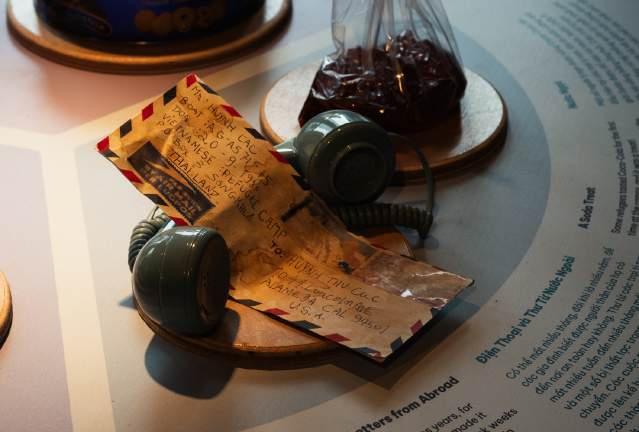

the forefront of her mind was “only the life (they) were leaving behind.”
“The shadows of war, escape, and displacement shaped our family in profound, lasting ways,” Mang wrote. “On the days we saw our mother, she shared beautiful moments of her upbringing in Vietnam. But the remembrances of war and a fallen country quickly overshadowed those memories. She recounted … a past filled with hardship and loss. I didn’t want to listen; the stories made me incredibly sad, and I found it easier to run away from them.”
When Mang became a mother herself, she found new interest and appreciation in the layers of her family’s story of resilience. Taking the time to engage with her personal history, she “began to reconcile with the sacrifices and trauma” that marked her family’s journey. This self-realization was her exigence for founding VBP and creating the exhibition: The collection’s main purpose was ultimately to “illuminate the strength, complexity, and humanity of the Vietnamese diaspora.”
The individual complexity of Vietnamese immigration experiences is highlighted throughout the exhibition. A banner in the exhibition displayed a quote from VBP podcast guest Yen Vu, which called attention to how perspectives on traumatic migration often contrast between generations in immigrant families.
“What to me is forced departure is perhaps to my parents and family a narrative of choice. Even when the country became unrecognizable for my parents, they would still say they ‘chose’ to leave,” Vu said. “I wonder if they have mythicized this narrative of choice as a way to remember things differently.”
The practice of shaping one’s memory is a point of interest in “Our Journeys.” Further exploring this, the exhibit displayed images of personal artifacts along a wall, corresponding to blurbs that explained the
significance of each to their beholders.
For example, Peter Nên Hoàng chose to submit a photograph of his martial arts training record. This record was among the few documents Hoàng prioritized bringing from home. According to the accompanying text, the training record “symbolized his identity, discipline, and pride in personal achievement.”
THE NGUYEN FAMILY
The once-prominent family of eight endured poverty and famine when they were separated by the war. The father and eldest son escaped by sea, but the mother, along with the rest of the children, worked to survive under communist rule. The children quit school and began working to provide for each other, while their mother sold black market goods. Doing so allowed her to form powerful relationships, which led to their eventual escape.
The exhibit showcased a few other personally significant artifacts with individual stories — the novels that hid Phướ c Tấn Nguyên’s escape plan, a comb “carved from the metal of a fallen plane” by Phuong Lien Palafox’s father for his wife, Cindy Nguyen’s “baby identity card” and Naoko Tsunada’s birth certificate which revealed her given Vietnamese name, Mỹ Thị Bùi. The submissions of Hoàng and others reveal that, for Vietnamese boat people, preserving one’s personal identifiers was equally as significant as survival. Hoàng’s martial arts training record was not vital to his survival of the journey, but to the continuation of his life.

THANH DƯƠNG BOYER
PHOTOS BY GIANA VISCONTI/THE OBSERVER
Simple possessions like nail polish bottles and a biscuit tin tell a quiet story of displacement — household items without a home.
A landline telephone and battered letter invoke a sense of vast distance that predates the digital age.

The exhibition addressed not just Vietnamese immigrants, but all individuals across their audience. The collection emphasizes feeling connected to oneself and one’s homeland, revealing “how individuals reconnect with the past, reclaim their narratives, and find belonging in the present.” Rather than only referring to Vietnamese boat people, the didactics urge awareness of the diverse histories of all.
As an intelligence officer for the South Vietnamese army, Lê was stationed in Huế when it was taken over by communist military. Lê and his fellow officers had to make the hasty decision to escape on a small boat by sea without saying their goodbyes. His family, fearing he died, searched prisons and re-education camps for 20 years. Decades later, they received a letter stating that he was still alive.
Dr. Carey Kasten, director of Fordham’s Initiative on Migrants, Migration and Human Dignity, also believes in the importance of history. Kasten pointed out that most non-indigenous Americans are descended from immigrants, urging that “we need to remember what it was like for them, the opportunities that were afforded to them and the ways they struggled.”
“I believe that working toward migration justice is key to our identity at Fordham,” Kasten said. “The fight for migration justice asks us to recognize the dignity of all persons and to stand with immigrants, in solidarity, as we work to achieve a more just, democratic society.”
Kasten stated the significance of community where there might be a divide, advising that “staying silo-ed and silenced is not the answer.” She also explained the role of art in bringing people together to celebrate diversity by helping us “process collective social trauma.”
The exhibition also addressed the specific experience of immigrant children, who were “caught between cultures and searching for a place to belong.”
Eva Lee, Fordham College at Lincoln Center ’27, is the daughter of Chinese immigrants and serves as president of
the Immigration Advocacy Coalition on campus. Lee described her experience growing up with distinct Chinese and American cultures as “very disorienting.”
Lee found her Fordham education in political science and Asian American studies to be very eye-opening on Asian American identity. She stressed the importance of learning “to create a more fair and complete picture of one’s own history.”
“Asian American stories … they’re so rich, and they’re also so homogenized,” Lee said. “If you live in a vacuum, very quickly you can fall victim to divisive politics and to stereotyping other people, and even stereotyping yourself.”
VBP’s exhibition details stories from a variety of Vietnamese immigrants, emphasizing their individuality. This effort combats stereotyping and dilution of Vietnamese history.
“Taking the initiative to learn about Vietnamese American history has taught me that … young people today are still deeply, deeply impacted,” Lee said. “People’s lives are still getting uprooted … because of certain political decisions. So it is so important to take a step back (and) look at these exhibitions and museums.”
While Lee stressed the importance of immersing oneself in diverse histories, she also pointed out that there is a “fine line and difference between … advocating for yourself … and also feeling the burden of having to educate everyone around you.”
“There is a sort of unspoken responsibility … placed among marginalized people in America of having to explain themselves, having to explain why they belong,” Lee said.
To reconcile being overwhelmed by societal and emotional pressures or feeling lonely, Ma urges marginalized students to “allow (themselves) to feel these emotions.”
“Remind yourself why you made this journey,” Ma said. “Your experience, struggles, and successes are part of a powerful story that no one else can tell.”
This exhibition debuts in unprecedented times, as topics of American discourse are being actively censored and immigrants across the states are being jailed before they can explain why they are in the country.
At the beginning of Trump’s second term, The New York Times published an article listing the hundreds of terms that were ordered to be limited or avoided by the federal government as the Trump administration seeks to purge “woke” legislation.

Among these terms were “multicultural,” “immigrants” and “community diversity.”
More recently, The Washington Post reported that an unidentified national park was ordered to remove signs and exhibits related to slavery.
“The removals were in line with President Donald Trump’s March executive order directing the Interior Department to eliminate information that reflects a ‘corrosive ideology’ that disparages historic Americans,” The Washington Post reported on Sept. 15.
But how do we define a “historic American”? Evidently, the current administration is working to depict a singular, homogenized picture of America in which immigration directly corresponds with an increase in crime, among other social problems.
The White House official website quoted President Trump in a “Fact Sheet” on his executive order to increase law enforcement in Washington, D.C. to “crack down on crime” in the capital: “Just like I took care of the Border, where you had ZERO Illegals coming across last month … I will take care of our cherished Capital, and we will make it, truly, GREAT AGAIN!”
In 1983, Hoàng and her five older siblings emerged from their hiding place inside a local temple to escape on a boat their father had been building for years. Her parents and younger siblings attempted the same plan two years later – but their boat capsized. Hoàng’s youngest sister was lost to the sea, along with their father who died trying to save her.
Between unconstitutional deportation policies and terminating Diversity, Equity and Inclusion-related offices, the Trump administration could not have a clearer goal: to sanitize the country’s history of multiculturalism and immigration, two key building blocks of the American foundation.
The current political hailstorm makes VBP’s exhibition even more significant, as they urge their audience to “honor (immigrant) journeys … and reflect on the enduring strength of the human spirit.”
Unless one is indigenous — another term now avoided by the federal government — Americans are all descendants of immigrants, a fact that should unify the country.
“Our journeys of migration, spanning continents and generations, are woven into the shared human experience,” the exhibition concluded. “Stories are our heirlooms, gaining deeper meaning with each retelling.”
VBP’s exhibition significantly reflects how learning about personal histories greatly contributes to cultivating diverse communities. Even through the “isolation and the quiet struggle” of Vietnamese boat people, they persevere through hardship and are able to connect through their resilience “to rebuild … Vietnamese communities.”
Many have expressed the importance of community building, whether that be in a new classroom or a new country. When asked for her advice for immigrant and international students going through hardships, Kasten replied: “Seek out community.”
“It can be hard to open up,” Kasten said. “(But) there are many people on and off campus who want to support immigrants in our communities.”
Lee, as president of the Immigration Advocacy Coalition, made sure to “say specifically that undocumented students have a place at Fordham.”
“I personally don’t think that citizenship matters all that much in regards to one’s humanity, and their human rights, and what they deserve,” Lee said. “I just care that you have shelter and food and the right to happiness … and a right to an education.”
Founder Tracey Nguyễn Mang also wants immigrant and international students to “know that (they) are not alone, even if it feels isolating at times.”
“Many before you have walked similar paths,” Mang said. “Lean into community (and) don’t be afraid to share your story … Hardship can feel overwhelming in the moment, but it shapes strength, empathy, and perspective that will serve you for the rest of your life — even if you can’t see it just yet.”
“Our Journeys,” by Vietnamese Boat People, will be exhibited in Chinatown until Sept. 28. The nonprofit will continue to empower the voices of Vietnamese immigrants, underlining that education on our migrant history is essential to strengthen the shared American voice.
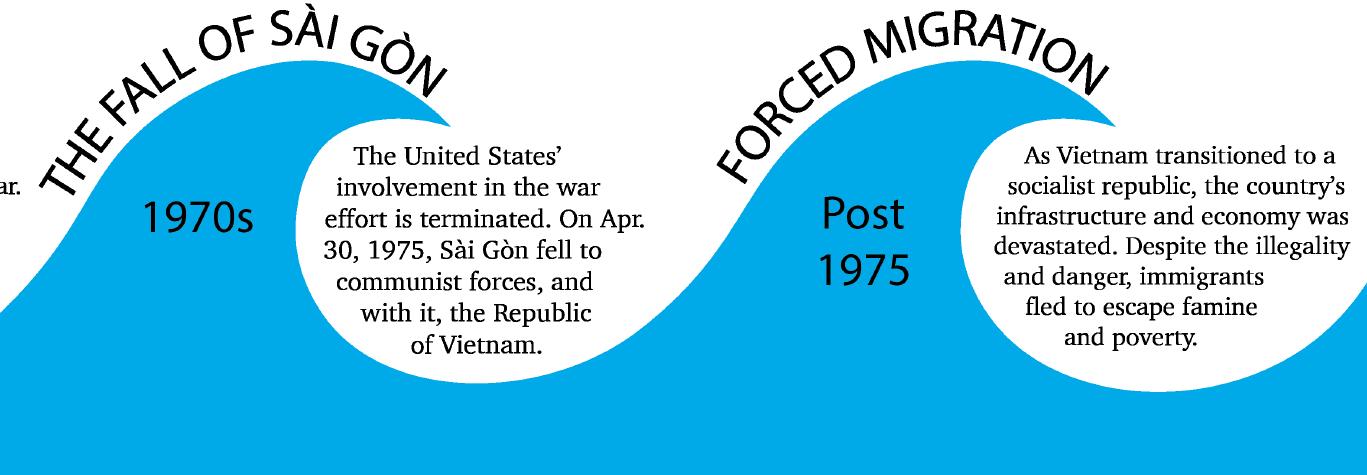
A recreation of a Vietnamese family’s kitchen emphasizes the significance of cooking as a means of preserving culture and passing down traditions.
50 years after the fall of Saigon, a younger generation of Vietnamese people grapple with their families’ stories and the questions that surface.
MINH LÊ
JOLIE PHƯƠNG HOÀNG
Opinions
The Performative Male: A Panopticon of Our Own Design
Authenticity is under fire as this widespread meme contributes to a culture of hyper-vigilance

As college students born into the digital age, we have grown accustomed — arguably against our will — to the ever-accelerating trend cycle. This constant bombardment of the senses has distorted our perception of what is in fashion. More disturbing, however, is the manner in which it has affected our conception of authenticity.
The “performative male” is the latest incarnation of this painfully predictable cycle, and while the memes were admittedly amusing in the early stages of their circulation, their continued pervasiveness implies a much darker story. To clear things up for any readers who may be miraculously and blessedly unaware of this archetype, the performative male can be defined as a man who leans into a calculated aesthetic as a means of attracting the attention of women. He adopts a blurry caricature of femininity that is both rudimentary and diminishing, all for the sake of sexual appeal.
We are on high alert, scanning the landscape for these frauds that our feeds have been made out to be prowling on every corner, reading in every bar, smoking on every stoop.
The performative male reads feminist literature in public as he pointedly sips on a matcha latte. He can be seen tapping his loafer-bound foot to the tune of Clairo ringing through his artfully tangled headphones.
What makes this ostensibly nefarious is the fact that the man in question is not engaging in these hobbies because he enjoys them. No, he is not reading bell hooks’ “All About Love: New Visions” because he is interested in her contemplations on contemporary relationships. The performative male does not even like matcha, and he most certainly cannot name five Beabadoobee songs.
The meme asserts that he must be hiding his true nature behind baggy jeans, niche records and, dare I say it, Labubus. He is playing the role of sensitive, progressive and feminine to lure in unsuspecting, often liberal, women. But do not panic — there is no need to fear the performative man. We have sniffed him out, and we are all pointing and laughing as we pat ourselves on the back for seeing past his shoddy masquerade.
Allow me to make myself clear: I do not deny that there are men out there feigning interest in these things to attract women. These types have always existed, and virtue signaling is, unfortunately, a tale as old as time. In fact, we have seen this very phenomenon countless times before — let us not forget the abhorred ghosts of buzzword past: the male manipulator, the poser and even their more archaic counterpart, the metrosexual.
However, this meme in particular has rapidly oversaturated our feeds to the point of ubiquity, and its underlying message is what I take serious issue with. Our scathing contempt for these so-called performative men has transformed into a profound prudence. We are on high alert, scanning the landscape for these frauds that our feeds have been made out to be prowling on every corner, reading in every bar, smoking on every stoop. We have all

become judges of authenticity, and in our valiant, albeit misplaced, efforts to root out “performativity,” we have made it increasingly difficult to engage in anything genuinely.
This threat has been grievously inflated, and as is customary in times of crisis, we look to irony to save us. The performative male contests popping up in metropolitan areas across the nation are a clear manifestation of this. Authenticity has become a slippery commodity, so we don an impenetrable armour of ironic self-awareness, guaranteed to ward off anyone who dare question our legitimacy. We have beaten our imaginary and omnipresent spectator to the chase. They cannot point and laugh because we are already laughing at ourselves.
But smug self-deprecation will never deliver us from the surveillance culture that we have slowly but surely burrowed into. As we continue to internalize these seemingly harmless memes, we reinforce the notion that anyone and everyone around us is a master of deception. When we project this fear onto every interaction, it inevitably returns to haunt us. If everyone else is capable of deceit, what exactly makes us exempt? We begin to dissect our every move, and doubt and embarrassment sneak in to replace what was once uninhibited enjoyment.
Even if we are confident that we are reading a book out of genuine interest or carrying a film camera for a love of the craft, who’s to say that this won’t be misconstrued at any time? Anyone on the street could be silently scoffing at our supposed superficiality — or worse, sending a photo of us to @hipsters_of_ny, an Instagram account with a following of nearly 140,000. Consisting of New York City-specific memes, the account features candid photos of eccentric New Yorkers accompanied by witty captions that ridicule any attempt at self-expression, disingenuous or not.
While this trend initially targeted men exclusively, it has been reposted and recycled to the point of senselessness. What was once a call to confront manipulative tactics wielded by men has since devolved into a directionless criticism of a popular aesthetic. Performative contests have swelled to encompass other communities — namely, masc lesbians — with one taking place
this past Sunday in Washington Square Park.
However, this variety of slander is not entirely arbitrary. There is an alarmingly subliminal theme lurking in the shadows of these performative fill-in-the-blank templates that, when examined with a critical lens, becomes unmistakable.
At the heart of our disdain lies a deep-rooted distrust in men, which is valid given the events of the last 200,000 years and the recent expansion of the virtual manosphere. However, when that distrust is founded entirely upon the assumption that any man who deviates from traditional expressions of macho masculinity is “tricking us,” our caution transforms into gender enforcement. In the midst of such a staggering wave of alt-right politics and escalating levels of transphobia in the U.S., it is no coincidence that individuals subverting the binary in any way, shape or form are being treated with suspicion.
The fact that our skepticism is largely targeting men exploring more feminine aesthetics and now women embracing masculine ones is both telling and terrifying. It implies that there is a “natural” and therefore more virtuous means of expressing gender, slyly fortifying the very notions that uphold binaries.
What was once a call to confront manipulative tactics wielded by men has since devolved into a directionless criticism of a popular aesthetic.
Given the current political climate, it is critical, now more than ever, that we scrutinize the media that we consume and share. There is nothing wrong with poking a little fun, but when it burgeons into a popular consciousness riddled with vigilance and cynicism, we ought to take a step back. Let us not forget that there are more pressing matters than whether or not a hypothetical man is drinking a hypothetical matcha for the “right reasons.”
GRACE SANTOLI/THE OBSERVER
Our accusations of performativity reflect our tendency to judge authenticity.
VEE VENNING Former Assistant Editor
AI is the Latest Addiction
The behavioral impact of artificial intelligence should scare us from using it

ANA WINSTON Managing Editor
For college students, whose brains are typically still developing, the dangers of addiction are constantly present. Thanks to Fordham’s mandatory alcohol awareness training and constant warnings from worried parents, it’s a well-known fact that the use of alcohol and drugs can easily fall into addictive patterns. Addiction isn’t just limited to substance abuse — numerous reports have warned that activities such as playing video games, scrolling on your smartphone and compulsive internet shopping can also become addictive. However, there’s one more emerging technology that should head the list of dangerous addictions: artificial intelligence (AI). As AI becomes increasingly ubiquitous, all users should be cautious of the psychological danger presented by AI.
The obvious danger comes from large language models (LLMs) like OpenAI’s ChatGPT or Microsoft’s CoPilot. LLMs are generative AI systems that allow users to prompt and receive answers from chatbots. LLMs are trained on large databases of texts, which are processed through algorithms that mimic human language and all of its biases. These algorithms are what enable LLMs to answer user prompts — not through actual thought, but through predictive abilities based on the algorithmic study of human texts.
AI is not just a homework tool — it’s a new form of socialization.
According to a study by Elon University, more than half of American adults have used an LLM, with 34% of them reporting daily use of the tool. LLM usage by teenagers is more common; a study by Common Sense Media reported that 52% of teenagers regularly use an “AI companion.” For 33% of those teenagers, the LLMs provide a form of social interaction. AI is not just a homework tool — it’s a new form of socialization.
It’s easy to see why this phenomenon emerges. Chatbots are easily accessible: they’re usually available for free, and they’re found via websites rather than applications you have to separately download. When one is given a tool that claims to provide an answer to any question, it’s not surprising that users turn to it with questions about the human experience.
The dangers of using AI for companionship or therapeutic relief have been revealed in a few landmark cases. In late August, a family sued OpenAI and its founder, Sam Altman, in the wrongful death case of their teenage son. According to a New York Times report, the family’s suit against OpenAI claims that
ChatGPT intentionally encourages psychological dependence and does not have enough safeguards in place to prevent the chatbot from providing life-threatening advice. Recently, Futurism — the publication that previously investigated Sports Illustrated’s AI writers — released an article on the effects of ChatGPT on various divorced and separated couples. The common thread between all the examples was that, for one of the spouses in the bereaved partnerships, a chatbot served as an echo chamber that validated their emotions and provided no pushback on their perspectives. The use of chatbots was found to inhibit couples’ therapy sessions or even simple constructive conversations, causing complex and often sour litigation processes for legal separation.
AI is now built into every platform, from Google’s Gemini to Microsoft’s CoPilot.
This summer, The New York Times published the story of Eugene Torres, an accountant who began using ChatGPT for help with his job. He ended up asking questions about simulation theory, the idea that the world is an illusion run by a higher being. The series of dialogues with the chatbot encouraged Torres into a spiral of delusion, as he thought he was suddenly clued into the falsity of reality by ChatGPT. The program did nothing to curb his descent into conspiracy and paranoia.
All of these distressing examples reveal the key danger behind LLMs: Though they mimic human speech, they do not even remotely understand human thought. They are echo chambers of the worst kind, because they manage to convince the user — through superficially original speech — that they are legitimate interlocutors. This quality of AI is understandably addictive, as explored by a study published this year by the Asian Journal of Psychiatry.
As someone who is firmly against AI and has proudly never used a chatbot for any reason, I read those stories with horror and fear. However, as much as I am against AI, I have unavoidably used it many times — without my consent. AI is now built into every platform, from Google’s Gemini to Microsoft’s CoPilot. Even Fordham Libraries’ third-party database management system, EBSCO, offers “natural language search,” a form of AI that parses a user’s query so that “more contextual clues and users’ intent can be honored,” according to EBSCO’s website.
In comparison to horror stories about chatbots, there are many innocuous forms of AI available for daily use. It might seem harmless to have Zoom’s AI summarize a meeting, or easier for Spotify’s AI DJ to pick your daily soundtrack. However, I

College students should be aware of the risk of developing addictive behaviors towards AI.
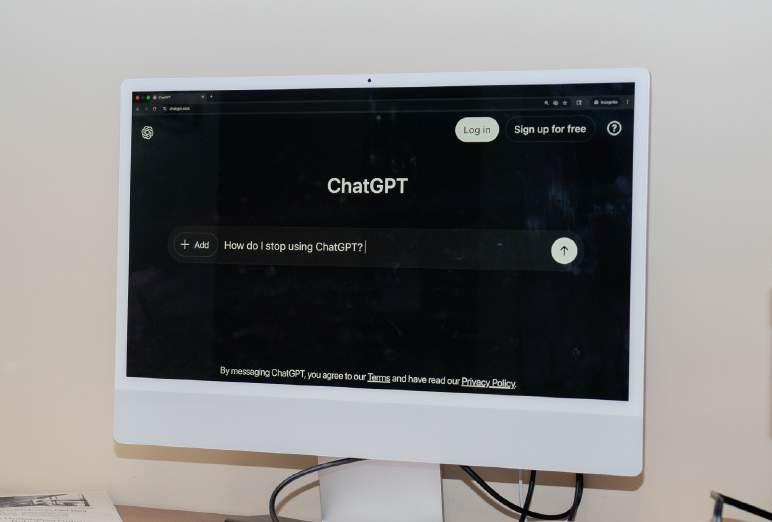
If we allow AI to skip the creative processes we dread, we surrender our chance to learn
argue that these kinds of AI are akin to a gateway drug, which leads us to complete dependence on the technology. Abstinence from AI should be encouraged whenever possible in order to evade the development of addictive behaviors.
Even with small tasks, surrendering your competence to the work of AI is slowly destructive.
I’m not trying to be sanctimonious or hysterical. AI does, in a lot of cases, make people’s lives easier. The question I’d like to raise is whether or not that ease is worth the possible risks. Even with small tasks, surrendering your competence to the work of AI is slowly destructive. If AI starts taking your meeting notes, why would you ever take notes yourself again? If AI autocorrects your essays every time,
how will you ever change your composition style for the better?
If AI suggests your music, why would you ever go looking for a new genre yourself?
AI makes life easier because it skips the creative processes we dread. You don’t need to think of an idea, you can just prompt ChatGPT. You don’t need to search a website yourself, you only have to ask the customer service chatbot to locate something for you. You can summarize a book without even opening the cover, and you can draw a picture without putting pencil to paper.
However, these creative practices have been part of human life for years. When you do them yourself, you are at risk of making a mistake — but that’s how you learn, and make things easier for yourself next time. You remember a meeting because you went through the process of taking notes and stimulated your brain. You find new research possibilities by going through texts you might not use, but might have something helpful in their footnotes.
Once you hand over your grunt work to AI, you’ll likely never want to do that work yourself again. That’s an appealing idea, but dangerous when scrutinized. After all, the aforementioned Torres started using AI for help with his office tasks, and ended up in a ChatGPT-induced spiral. While that’s not going to happen to everyone, I argue that the possible risks of AI should inform every single use of the technology, even its innocuous forms that are built into websites and applications. There’s a litany of arguments against the excessive use of AI, which cite its frequent plagiarism, implicit racial and gender-based linguistic bias, and harmful impact on the environment. Its addictive nature, and the degenerative mental effects that can be caused by over-dependence, should be added to the list of diatribes against the technology. When you’re thinking about opening ChatGPT, maybe the lesson taught by your old D.A.R.E. program officials should apply — just say no, it’s more dangerous than it’s worth.

KEI SUGAE/THE OBSERVER
GRACE SANTOLI/THE OBSERVER
from our mistakes.
Rubberneck
Not Afraid of Saxbys? You Should Be
The Ram-fications of hiring Gabelli students as baristas must be kept in mind

TUCKER FLYNN Opinions Editor
Unless you’ve been living under a rock, you’ve seen and heard tell of the mythic student-run cafe known as Saxbys, currently under construction where Argo Tea used to reside. While Fordham Rose Hill has been blessed with amenities such as food delivery robots and a single nap pod for commuters (tuition hikes from last year unrelated), Fordham Lincoln Center (FLC) has enjoyed an enduring promise of a replacement cafe “opening next month” for the past six months.
Except the title of “replacement cafe” doesn’t do Saxbys justice. It’s known by a name that bears much more gravitas: An Experiential Learning Platform Cafe (ELPC). If you’d like to witness this awe-inspiring exhibition of corporate jargon for yourself, head down to Saxbys and look across from the counter, where your excitement for the ELPC will be uninhibited, save for the nausea induced by the newly-ugly Fordham logo emblazoned nearby on the wall.
Turning back to the ELPC itself, you’re greeted with white subway tile, bamboo slats and multiple iPads already turned toward the customer, primed and ready to ask you for a default 22% tip. You’ll feel like you’re getting a complete Bushwick cafe experience as you avoid eye contact with your barista — who also happens to be the student who asks to copy your homework in Texts and Contexts — while scrambling to find the no tip option.
The illusion will shatter, however, when you notice that they seem to have mistakenly applied all of their available blue pigment to their exterior walls instead of saving it for the hair of their employees. Earlier this week, I walked past what appeared to be new employees in training, and I can only say I was aghast. There was a suspicious lack of experimental body piercings in the crowd. I trembled at the thought of how my dirty chai with oat milk — a trustworthy order from the bygone era of Argo Tea — would taste after being prepared by these hands.
The disproportionately high concentration of blue hair per capita of Fordham College at Lincoln Center (FCLC) in
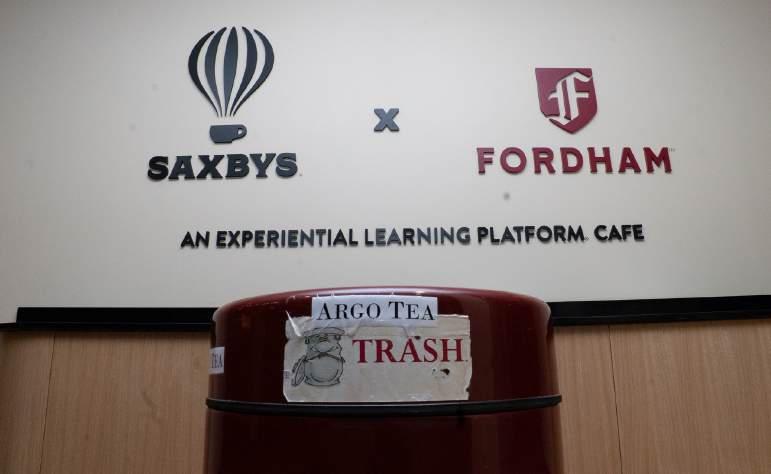
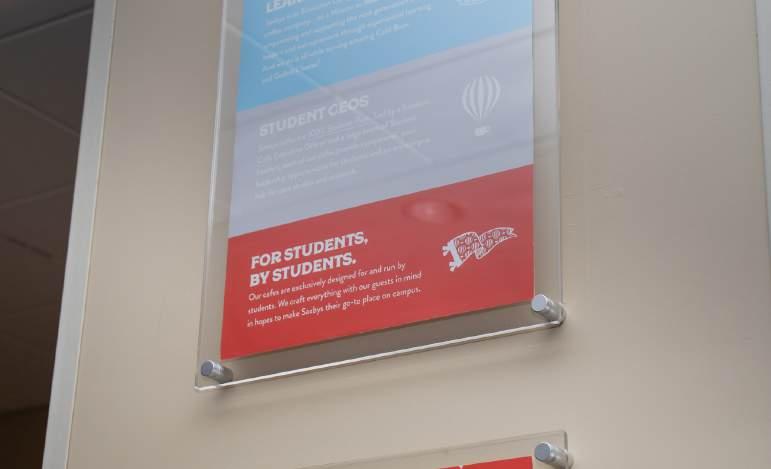
comparison to Gabelli indicates that Fordham would be better served in encouraging its entire student body to apply when staffing Saxbys’ leadership. Instead, by allowing Gabelli students to lead the charge, the ELPC becomes a marketing ploy solely designed to bolster Fordham’s rankings as a business school.
Undeterred by baristas with minimal potential, Saxbys is charging toward a triumphant grand opening, hailed by Ram Hospitality as “the news (we’ve) all been waiting for” in a recent
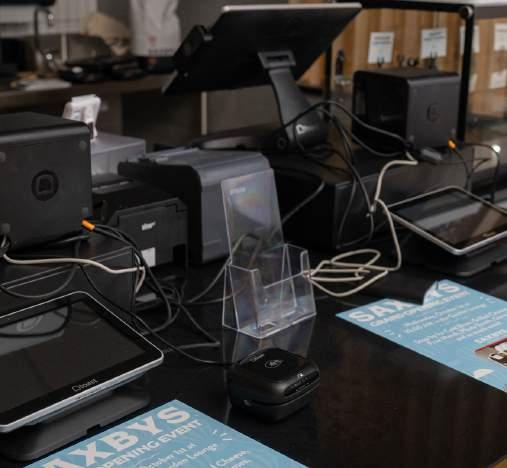
university-wide email. Just in case the tidings of this grand ceremony didn’t adequately stoke the flames of your excitement, you’ll also be able to play games, utilize the photo booth, acquire free merch and find out just what Saxbys means when they make the increasingly terrifying promise of “so much more!”
Don’t get too excited, because at its core, Saxbys adheres to its Fordham-specific slogan of “For Rams, By Rams.” That’s right — Saxbys is 100% student-run, and it definitely tastes like it.
You might be wondering what grounds we have to cast aspersions upon the culinary delights of a cafe that has yet to open.
At the Saxbys tasting event last spring, where FLC students were graced with the rare presence of University President Tania Tetlow, I had the honor and privilege of receiving a 3-ounce Dixie-adjacent paper cup containing a mysterious beige liquid that the suspiciously cheery Saxbys corporate employees attempted to pass off as authentic spiced Indian tea blended with an appropriate
ratio of sugar and milk. They were also distributing slivers of their well-advertised french toast muffin, which I found notable for its sandy texture and notes of burnt petroleum.
If you can believe it, the sandy muffin wasn’t even the greatest disappointment I experienced. My eyes were set on a higher prize.
In true Michelin Guidebook fashion, Saxbys has seen fit to include a steak grilled cheese in its catalogue of easily microwaved foods. I arrived at the tasting with my mouth watering at the thought of enjoying this advancement in the frontier of cuisine, but found myself plunged into the depths of despair upon realizing that they had excluded this delicacy from their tasting menu. It seems that I will have to wait until the grand opening to test the Saxbys menu’s claim that they’re “not loafing around with this one.”
Also notably absent was the pickle grilled cheese, without which the diaspora of hot sandwiches would be doomed to remain forever incomplete.
As we count down the days till that months-in-the-making ceremony, this much is clear: Saxbys’ inadequate staffing strategies and concerningly creative menu promise a disappointing substitute for Argo Tea.
Much like a fraternity president addressing hazing reform, the student cafe executive officer (SCEO) will have much to contend with as this haphazard operation begins. Fordham may not have Greek life, but we do have Gabelli bros.
If you’re interested in knowing more about the esteemed and elusive SCEO, don’t worry. You need only cast your eyes upon the inch-thick plaque affixed to a column in the middle of the space in front of Saxbys with comically large metal fasteners.
In the case of The Observer v. Saxbys, much is still unknown. However, one thing can be known for certain. Come Oct. 1, I’ll be in line eagerly awaiting that exhilarating combination of toothache-inducing chai, a disappointingly dry muffin and a carefully practiced brand of passive aggression known only to the most valuable members of Fordham’s student body who never fail to make sure that everyone knows they have much more important things to be doing. After all, when hypocrisy calls, we answer.
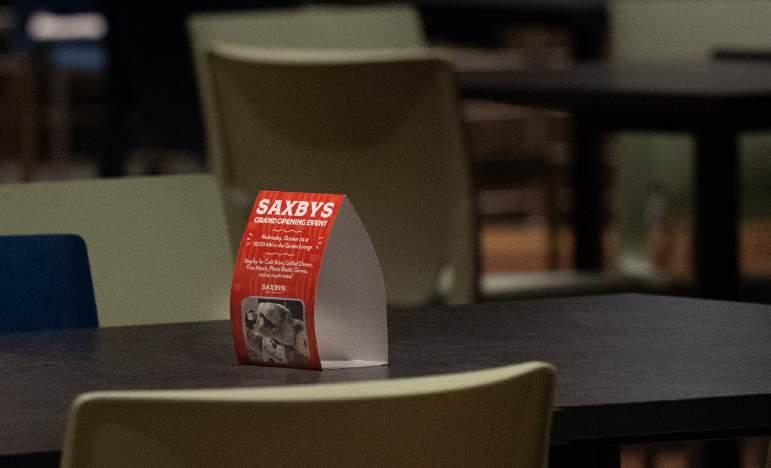
PHOTOS BY GRACE SANTOLI/THE OBSERVER
They can’t erase the relics. Even the trash cans know that Saxbys doesn’t belong here.
Saxbys claims to be an “educational company disguised as a coffee shop.” Guess what else it’s disguising?
Saxbys has been a month away from opening for what feels like six months.
Even a student-run cafe can’t escape tipping culture.
Arts & Culture
Stove’s Comedy Club: An Intersection of Comedy and Community
Fordham Lincoln Center’s comedy club provides a space for exploration and entertainment alike
By MARA HOLZEN
Contributing Writer
On Sept. 12, laughter rang out from the basement of the 140 West 62nd Street Building as a group of students pretended to fight like kindergarteners on a playground, take a lie detector test and hunt for jellyfish during Stove’s Comedy Club’s first show of the year, titled “Hide and Go Stove’s.”
The performance aimed to showcase returning members of the club and introduce the group to Fordham students. Stove’s was founded in 2013 and is the only comedy group at Fordham Lincoln Center. There is no audition required to join, and students of all experience levels are encouraged to participate. The club offers members opportunities to hone their skills in improvisation, sketch performance and stand-up comedy.
Three members of the Stove’s executive board recall that when they joined the club as first-years, they felt drawn to the group by their mutual interest in comedy.
The club’s vice president Ephram Oliver, Fordham College at Lincoln Center (FCLC) ’26, was hoping to find “creative connections” to aid in his filmmaking work, while social media manager Colin Dowd, FCLC ’26, was looking for a performance club with “a community around it.” Additionally, club president Jake Colangelo, FCLC ’26, recalls first encountering Stove’s at the club fair and feeling an instant connection.
“There’s something in people
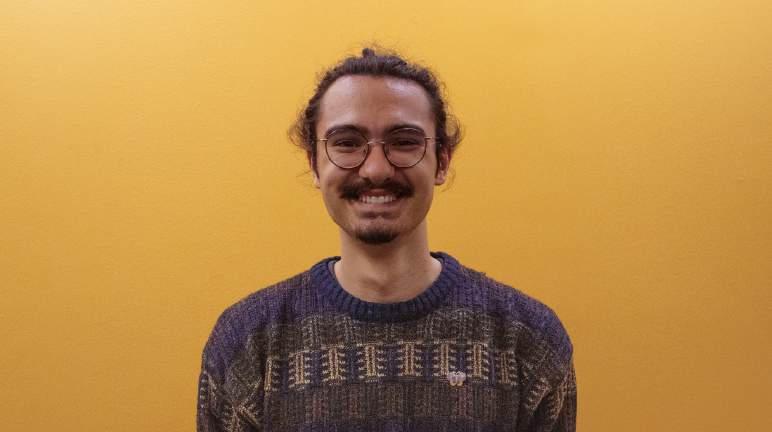
Stove’s Comedy Club President Jake Colangelo, FCLC ’26, has been with the club since his first year at Fordham.
who do comedy, or meeting people and the word comedy is in the air,” Colangelo said. “It opens the door in a fun way. (It’s) almost like being given the permission to joke.”
He soon “fell in love with” the club because it provided a space for students interested in comedy to work together and share their passions.
Everyone in Stove’s has the opportunity to learn improvisation, sketch comedy and stand-up, and many of the group’s performances showcase all three. To Colangelo, these disciplines are “comedically transferable,” as experience with each practice strengthens performance in
the other areas. Oliver believes another benefit of this multifaceted approach is “a more realistic expectation for how comedy plays out professionally” for members who hope to pursue comedy outside of a college setting.
The meetings are structured so that club members can combine their efforts across each form of comedy. This exploration is “partially what Stove’s is about … opening our mind to what comedy can be,” Dowd said.
Rather than immediately specializing in one area or another, members of Stove’s can learn about aspects of comedy they may not have previously considered. Both Dowd and Oliver liken
this to exercise, saying that this sort of work helps them develop their comedic “muscles.”
Colangelo said he believes the spirit of collaboration and exploration is an integral part of the comedy club’s culture. He identifies the group’s tight-knit nature and comedic diversity as “what makes Stove’s so unique as a non-audition multidisciplinary club,” describing their work as a “strange, beautiful thing that comes out of collaborating with 20 different artists on a single production.”
Indeed, many aspects of comedy, particularly improv, rely heavily on teamwork among performers. In one game played in
the show called “New Choice,” a performer pressed a buzzer to interrupt their scene partners, forcing whoever spoke last to change their previous line. Performers would pivot from agreeing to disagreeing with a scene partner, from being unsure to enthusiastic about a decision, and in one case, from loving to hating their parents. The other performers would then immediately attempt to justify what had just been said, resulting in hilarious chaos.
Stove’s provides a space for students to engage with comedy and with their community, and right now, as Dowd said, that space is especially crucial.
“The world is hard to face,” he said. “I think you need comedy … there’s a reason people say it’s the best medicine — because it is.” Oliver also acknowledged comedy’s ability to “lift people up,” and proposed that comedy can be a tool for “questioning power” and “(creating) community where community can often be suppressed.”
Stove’s Comedy Club is currently welcoming new members and meets every Wednesday at 7 p.m. in G76B. Colangelo encourages anyone who may be interested in comedy to “come join us … we would be thrilled to have you”.
The next Stove’s show, which will be performed in the style of a game show, will take place in the Lowenstein South Lounge on Friday, Oct. 10. Stove’s can be found on Instagram and YouTube at @stovescabincrew.
The Choreographic Process Takes Center Stage at the Guggenheim
The nonprofit group Works and Process hosted a preview and panel for a new work for New York City Ballet.
By INDIRA BUSH Contributing Writer
On the evening of Sunday, Sept. 14, when all daytime visitors had gone home, the Solomon R. Guggenheim Museum bustled with another group of art enthusiasts. These patrons were gathered for an exclusive preview of choreographer Jamar Roberts’ new work for the New York City Ballet (NYCB).
The piece, which is yet to be titled, will debut at NYCB’s annual Fall Fashion Gala on Oct. 8, featuring costumes by Dutch haute couture designer Iris Van Herpen and music by Venezuelan musician Arca. Thanks to the nonprofit group Works and Process, attendees were able to experience a sneak preview and a look behind the scenes.
Works and Process, which was founded in 1984, has grown to both support artists and encourage audiences to “participate beyond the stage.” Their creative residencies across five states provide artists with more than just funding — they also offer studio access, housing, health insurance enrollment and a transportation stipend, allowing grantees to fully dedicate themselves to their work. Their events, which take place at the Guggenheim — as well as at Manhattan West, the New York Public Library for Performing Arts and City Park Foundation’s SummerStage — invite audiences into the creative process.
Works and Process Executive Director Duke Dang described these events as “show and tell for
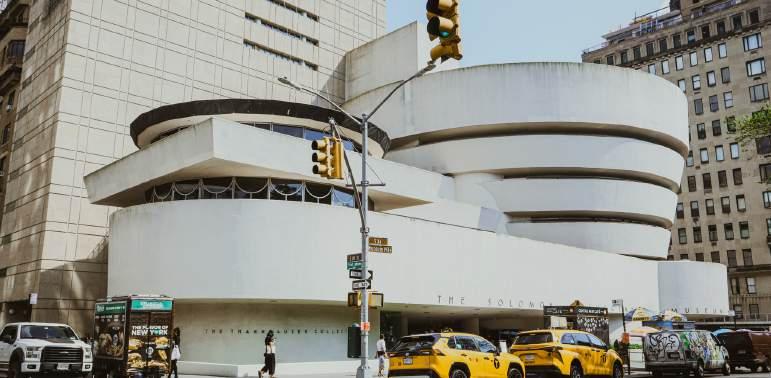
This fall, the Solomon R. Guggenheim museum doubles down on interdisciplinary arts programming.
adults” and stressed the importance of opportunities for education on the creative process, especially in a time when compulsory arts education is lacking. Roberts previously danced and choreographed for the Alvin Ailey American Dance Theater, and has created many commissioned works for renowned companies across the country — including two others for NYCB. He has taken part in multiple Works and Process residencies.
The audience got a look into Roberts’ creative mind through a panel discussion with NYCB Associate Artistic Director Wendy Whelan. Their conversation began with a focus on his original creative spark: climate protesters
at a NYCB performance this past Earth Day. After lamenting the interruption, Roberts shared that he agreed with the sentiment and wants to explore the conflict between human technology and nature in his new piece.
The panel then meandered through every part of the rehearsal process. Roberts discussed his desire to create a dance that looked like technology, comparing the movements he created to Barbies, Legos and G.I. Joes — prompting a chuckle from the audience. Other inside creative knowledge included everything from where Roberts stands in the practice room — all the way in the back — to the creation of the costumes.
The anticipation was obvious
between Whelan, Roberts and the dancers themselves. Whelan complimented the dancers’ versatility, calling them “a super open group,” and stressed her confidence in giving Roberts full creative license. Roberts admitted that he had surprised himself with his own willingness to take risks, going as far as to warn that the piece “could be a total flop or a total success.” Meanwhile, the dancers praised Roberts, crediting him as a remarkably collaborative choreographer.
Between panel discussions, two excerpts of the piece were performed by four current members of the corps de ballet, two soloists and one principal. Wearing everyday rehearsal attire, the
dancers stunned with sharp, angular movements in what seemed like a constant battle to overpower each other’s perfectly-timed limbs — fitting for Roberts’ technology versus nature storyline. The music was full of technologically distorted sounds, immediately bringing the audience into the eerie and intense world of the piece.
The first excerpt, just a couple of minutes in length, elicited an audible “whoa” from the audience as it came to a close. The second excerpt, which Roberts hinted at being from the end of the full work, moved slightly away from the intense angularity of the first, becoming more gentle. The dancers moved in almost complete synchronization, impressing with their unwavering elegance through calm and precise movements.
As the night progressed, members flowed into the Guggenheim rotunda for the post-show conversation, a routine part of Works and Process events. Through casual, unmoderated conversation, attendees were able to discuss what from the night felt most important to them. Topics ranged from favorite choreographic moments, to particularly powerful comments made at the panel, to which NYCB shows each fan had already purchased tickets for. All around, the enthusiasm and adoration of the art perfectly encapsulated the Works and Process mission, proving that when you truly admire something, every step and small detail is worthy of obsession.
LUCIEN FISCHER/THE OBSERVER
ARSHIA CHAKRAVARTTI/THE OBSERVER
The People Yearn for Quality Cinema
Regal Cinemas is screening old movies for a reduced price — is Hollywood on hiatus?
By GABBY MACRE Contributing Writer
Silence followed the opening credits. A spaceship orbited Earth, then blinked out of sight. The title card for John Carpenter’s “The Thing” burned on screen to a jarring futuristic sound effect and the theater erupted into applause.
Originally released in 1982, “The Thing” came back to the silver screen for one night only on Sept. 11. For many theater attendees, it was their first time seeing the film starring Kurt Russell and Keith David. Classics like this one are being shown in theaters across the country for Regal Cinemas’ “Month of Masterpieces.”
Regal announced the launch of the now-annual event in late August and kicked it off on Sept. 1 with “Paper Moon” (1973), directed by Peter Bogdanovich. The rest of the month featured films like “The Shawshank Redemption,” “Inception” and “The Godfather,” providing younger audiences a chance to see films released before they were born.
In her statement to the press, Regal’s newly-appointed Head of Marketing Vikki Neil stated that ticket prices would be $8.99, a “nostalgic reduced price” to usher in a multi-generational audience of film lovers.
The president of Fordham Lincoln Center’s Screenwriting Club, Alexandra Irwin, has already seen “The Godfather” and is excited for the screenings of “Casablanca” and “Close Encounters of the Third Kind.” Given her interest in film, she views re-releases as a “re-exposure to culture.”
Perhaps this event is just what the current landscape of film

needs to inspire the next generation of directors like John Carpenter. “The Thing” is a remake of “The Thing from Another World” (1951), which Carpenter recalled seeing at a re-release in the film’s behind-the-scenes documentary “The Thing: Terror Takes Shape.”
At the Union Square Regal’s screening of “The Thing,” the excitement to see the tense sci-fi thriller was palpable, from the wide-eyed expressions of firsttime viewers to the nervous laughter during particularly gory scenes.
There is undoubtedly value in re-releasing classic films. New audiences are able to appreciate key elements of the film medium, like sound and visual effects, that can go unnoticed on a phone or laptop screen. Fordham professor of communications and media studies Michelle Prettyman said, “There is a way to think about
filmmaking that shapes everything you’re going to do … when people make what they make, there is a real investment in seeing it through.”
However, Prettyman raised concerns about the causes and effects of theaters prioritizing re-releases in favor of new releases. It is a short-term solution for a troubling trend: Fewer movies are being made and fewer people are going to the theater. There is a huge financial incentive to fill seats, and to do so, the industry is relying on nostalgia-bait.
“The industry is in such a strange place that it’s trying to do what it can to get more interest in exhibition,” Prettyman said.
More often, theaters are getting into the habit of re-releasing classics. In fact, Regal is slated to show another series of classic films — horror movies, in this case — for the month of October with
their “31 Screams on Screen.”
It is no shock that the film industry is in what Prettyman aptly described as a “stalemate,” given that most of the films Hollywood pushes are part of an existing franchise, like this summer’s “Superman” or the latest addition to the “Jurassic Park” franchise, “Jurassic World Rebirth.”
Re-releases can be understood as a representation of audiences’ desire to see a new and meaningful piece of media. Irwin pointed out the disillusionment people feel from having the world at their fingertips. The big screen provides an escape, but original films like Ryan Coogler’s “Sinners” are few and far between, which explains why it motivated so many people to go to the movies back in May.
Audiences want quality cinema, and Prettyman believes there are more effective ways to boost ticket sales besides re-releasing old films. She suggests theaters host mini film festivals, where attendees can have the opportunity to see short films, art films and documentaries, and to speak with filmmakers, establishing theaters as community-building spaces.
There are more than enough new, boundary-pushing films set to be released in Hollywood and beyond. Prettyman encourages Fordham students to see films by directors they are not familiar with and take advantage of being in New York City by going to any film festival they are able to attend.
This year’s New York Film Festival runs from Sept. 26 through Oct. 13, with discounted prices for students. If any classics are on your watch list, they are best appreciated in theaters.
Roman Ondak’s ‘Waiting for Someone to Ring at My Door’
The exhibit at Peter Freeman Gallery is a rare chance to see free, beautiful, important art
By ELLIOT RICHTER Contributing Writer
“Waiting For Someone to Ring at My Door” is the latest exhibition of Slovakian multimedia artist Roman Ondak’s work, surveying his career from shortly after the fall of the Soviet Union to the present. Both Ondak’s mastery of composition, deconstruction and storytelling, and his assertion that art can help us through the most trying of political crises make for a remarkable exhibition.
The gallery evokes both a cathedral and an old Soviet-style apartment: Your eyes are drawn heavenward, not to some stained glass window or gilt saint, but instead to a plain doorbell, the exhibit’s titular work. Ondak salvaged the bell from the trash of his childhood apartment building in Žilna, Slovakia, then called the Czechoslovak Socialist Republic under the influence of the USSR.
Walking around the gallery, you are faced with a second contradiction: Everything is both intimate and distant. You sit in what feels like a family’s living room — there are pictures of children, sculptures, windows and a set of the artist’s son’s keys sitting in a lock. The works “Elements II” and “Untitled (60),” composed of used teabags, imply that at some point in time and space, people gathered, drank tea, talked and felt joy. However, there is a coldness.
Woven into this intimacy are four unfinished crossword puzzles: “Unsolved Crossword,” “Squaring the Circle,” “Vanishing”

By SOFIA LAJE Contributing Writer
“URCHIN” DIR. HARRIS DICKINSON (2025)
IFC Center via 1-2 Special - Opens Oct. 9
Following its premiere in the Un Certain Regard section at the 2025 Cannes Film Festival, “Urchin” marks a striking directorial debut from actor-turnedfilmmaker Harris Dickinson. English
“IT WAS JUST AN ACCIDENT” DIR. JAFAR PANAHI (2025) Film Forum via NEON - Opens Oct. 15
Iranian filmmaker Jafar Panahi reflects on revenge and moral choice in his 2025 Cannes Palme d’Or-winning film that was recently selected as France’s Oscar submission. Persian with English subtitles
“KÖLN 75” DIR. IDO FLUK (2025)
IFC Center via Zeitgeist in association with Kino Lorber - Opens Oct. 17
Inspired by real events, this stylish period piece that premiered in the official selection of this year’s Berlin Film Festival follows 17-year-old Vera Brandes as she races to organize Keith Jarrett’s legendary Köln Concert that almost never happened. English, German with English subtitles
“THE MASTERMIND” DIR KELLY REICHARDT (2025) Film at Lincoln Center via MubiOpens Oct. 17
Kelly Reichardt returns to the New York Film Festival with a meditation on guilt, identity and reinvention in a suspenseful character study exploring the aftermath of an art heist, starring Josh O’Connor and Alana Haim. English
“BYE BYE LOVE” DIR. ISAO FUJISAWA (1974)
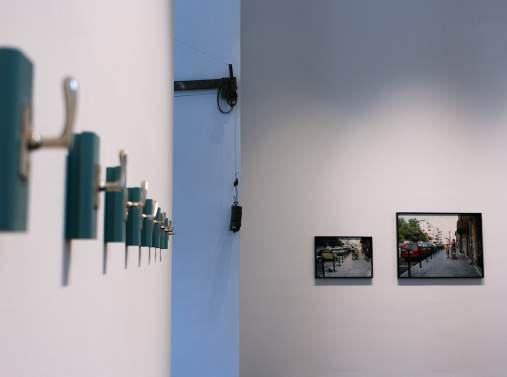
and “Labyrinth.” The viewer is made to wonder why these confusing puzzles, painted in brilliant, enticing colors, were left unsolved in a space where people clearly gathered and played games and relaxed. What was left unspoken?
Ondak’s living room is an “unspace” — both lived in and empty. Such is the result of political repression, as explained by Ondak’s art: No matter how intimate your surroundings, something remains unsaid, unreal and unsolved because it is impossible to speak the truth with the government’s boot on your neck.
Ondak’s childhood was marked with oppression. He grew up in a country where every work of art, no matter how large or small, was
propaganda, funded and shown expressly for the glorification of the state. Halfway through his time at the Academy of Fine Arts in Bratislava, however, the Berlin Wall fell and shortly after, so did the system that left the vivid crosswords unsolved. Liberated from artistic restraints, Ondak could share his experiences and paint the solemn reminders of what he was never allowed to express at the time. Walking to the very back of the second room, you encounter two twin photos of men — the artist, looking triumphant, and his father, looking concerned. Both are reading the same paper: A 1968 edition of a local Slovakian publication, with the headline announcing the literal
crushing of the Prague Spring independence movement under tank treads. This set of photos, titled “Bad News is a Thing of the Past,” is Ondak’s thesis: No matter how hopeless, unsolvable or distant the world feels, there is still intimacy, hope, a vividly-colored horizon to triumphantly gaze upon.
Ondak’s work is an iconic fixture in the world of contemporary art; his art has been shown in prestigious museums such as the Museum of Modern Art here in New York, the Tate Modern in London and the Slovak National Gallery. The current exhibit at the Peter Freeman Gallery is a unique chance to see some of Ondak’s most famous works entirely for free.
No matter how hopeless, unsolvable or distant the world feels, there is still intimacy, hope, a vividlycolored horizon to triumphantly gaze upon.
“Waiting For Someone to Ring at My Door” is showing at the Peter Freeman Gallery until Oct. 25. The gallery is located in SoHo and is open from 10 a.m. until 6 p.m., Tuesday to Saturday. Next time you have a free 30 minutes between popups or boutique trips, be sure to stop by to experience something beautiful, profound and deeply relevant.
Metrograph via Kani ReleasingOct. 10 to 12
“Breathless” meets “My Own Private Idaho” in this standout from Japan’s “jishu eiga” (self-produced film) movement, which, fifty years after its release, is making its U.S. theatrical premiere. English, Japanese with English subtitles
“PAN’S LABYRINTH” DIR. GUILLERMO DEL TORO (2006)
Village East by Angelika - Oct. 14
Ahead of the release of his highly anticipated new film “Frankenstein,” revisit Guillermo del Toro’s modern fairytale “Pan’s Labyrinth.” As young Ofelia escapes into a dark mythological world, reality and fantasy blur in a film that remains as emotionally powerful and visually breathtaking as ever.
Spanish, Russian with English subtitles
FILM
63RD NEW YORK FILM FESTIVAL AT LINCOLN CENTER
Sept. 26 through Oct. 13
“Returning every fall, NYFF has been an enduring part of New York’s rich cultural and historical landscape since 1963.” (filmlinc. org/nyff/)
BROOKLYN HORROR FILM FESTIVAL AT NITEHAWK WILLIAMSBURG Oct. 16 to 25
“The Brooklyn Horror Film Festival is a premier east coast genre festival that embodies the spirit of Brooklyn, showcasing the best new independent horror films.” (NitehawkCinema.com)
KEI SUGAE/THE OBSERVER
Regal Cinemas launched the 2025 “Month of Masterpieces” program at select theaters across the country in September.
HELENA FRANCO/THE OBSERVER Ondak’s sculptures, though modest in scale, pack an outsize emotional punch.
Social Media Trends Reshape Student Life at Fordham
From motivation to distraction, students navigate the dual impact of TikTok and Instagram on campus culture
By DENISE RODRIGUEZ VARGAS
Contributing Writer
From endless scrolls to trending sounds, social media has become part of the rhythm of campus life. For many students, TikTok and Instagram serve not just as entertainment, but as quick escapes from the pressure of deadlines. In the library, phones glow under the dim light as students sneak a scroll between notes. In the Ram Café, groups gather around one screen, laughing together at a viral clip.
According to a report by Tori DeAngelis in the American Psychological Association’s Monitor on Psychology, teens in the U.S. now spend an average of nearly five hours a day on social media. This level of engagement shapes how students balance their time and connect with one another, making social media a central factor in both academic and social life.
“ Usually when I say I need to lock in, it can mean at the gym or perhaps with my studies. ”
Tiffany Wu, FCLC ‘26
Hashtags not only organize content but also shape how students talk about their goals and struggles. Two that have recently gained traction are the #LockIn trend, which encourages focus and productivity, and
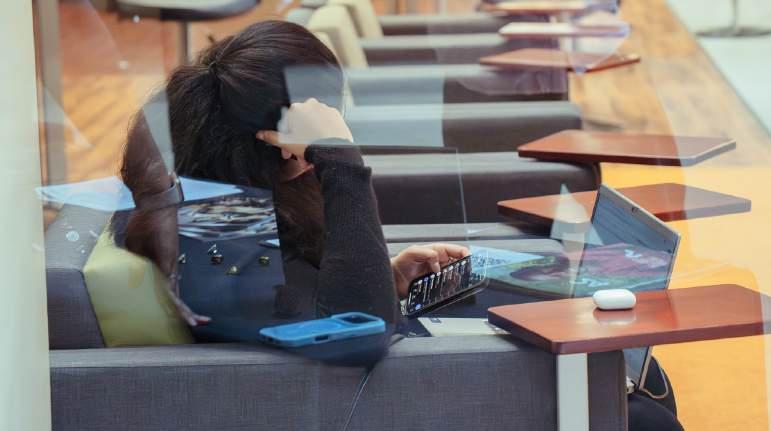
#LockedIn: students share popular hashtags to seek a sense of togetherness in the struggles of the academic day to day — but this phenomenon has also created heightened competition among peers.
the #AcademicValidation trend, which highlights pressures around achievement and recognition.
Tiffany Wu, Fordham College at Lincoln Center (FCLC) ’26, described how she incorporates the #LockIn phrase in her daily life.
“I think it is a phrase you use to describe really dedicating yourself to a particular goal, whether it be in the moment or in the grand scheme of things,” Wu said. “Usually when I say I need to lock in, it can mean at the gym or perhaps with my studies.”
The term has slipped into everyday conversations among students, often used as both a joke and a serious reminder. “Lock in” pops up in group chats, appears scribbled on whiteboards in study
rooms and is even exchanged casually in the gym, evidence of how a TikTok trend has crossed into the language of campus life.
Wu noted both positive and negative effects of the trend. What begins as motivation can easily spiral into procrastination, raising questions about whether these platforms truly help students or simply repackage their struggles in viral form.
“I truly use TikTok as a source of motivation,” Wu said. “But I also fall victim to doomscrolling when I should be doing work, so I think it can go both ways.”
Other students echoed this experience of balancing between motivation and distraction. Juan Hernandez, FCLC ’28, said that constant scrolling was once a
major part of his routine.
“When I had TikTok, I definitely utilized it way too much, far too often, and quite honestly, it was the reason I deleted it,” Hernandez said. “But nowadays Instagram Reels takes up more time than it probably should, though not enough for me to justify deleting Instagram.”
For Hernandez, the #LockIn trend also reflects what he sees in Fordham’s student culture.
“A lot of Fordham students I’ve encountered have fully participated in this trend,” he said. “A lot of my peers have this kind of work-hard, play-hard mentality. In other words, they’re often proponents of setting aside time to really focus and work on the things that you need to work on.”
The #AcademicValidation trend reflects a different side of student life — one that emphasizes grades and external recognition. In one viral video, TikTok user @rissypissy16 captioned their post “Trying to explain to a normal person why I’m crying in the bathroom stall over a 90 on my test” and tagged it with #academicvalidation. The clip has earned over 600,000 likes, and the comments reveal a divide.
One user wrote, “Give us a real problem,” while another chimed in, “Yes it’s a good score, but not good enough.” Thousands of similar posts showcase this tension, with some students treating the trend as encouragement and others criticizing it for fueling unhealthy comparison.
Isabelle Diaz, FCLC ’27, has mixed feelings about the trend.
“That sense of productivity online, yes, it can be motivating, but it can also just make people fall into that trap of watching more videos,” Diaz said. “So even though it might have a good purpose, I think it’s more about the aesthetics of it, and it doesn’t really do much for the person.”
Her classmate, Mariana Miranda, FCLC ’27, expressed similar concerns.
“I think watching other people’s successes and comparing yourself to other people could serve as motivation,” Miranda said. “But obviously, everything in extremes is bad.”
Across campus, the phone screen remains a powerful presence. Whether serving as a tool for focus, a source of distraction or a reminder of competition, social media continues to define how students experience college life.
Four (Underrated) Books You Should Add To Your Fall
By KATIE BROSKY Asst. Opinions Editor
It’s time we start getting our book recommendations from the real world — not TikTok. Remove yourself from an echo chamber of trends and instead, directly engage with your community. Talk to clerks at bookstores, ask your friends what they are reading, go to your local library and scour the shelves, observe the books strangers are holding on the subway. Or here, I will make it easy for you: Read the newspaper.
‘THE BODY’ BY STEPHEN KING
The king of horror is an obvious choice for the season, but if you happen to be anything like me and avoid stories you know will keep you up at night, I would suggest picking up “The Body.” This coming-of-age novella follows four boys on the brink of adolescence as they take off from home on a mission to find the body of a boy who disappeared in the woods. If you think this plot sounds familiar, it might be because you have watched its film adaptation, the 1986 movie “Stand by Me.” But, like always, the book is better. There is a lot to appreciate within its short stature, but the narration is at the top of the list. Decades after the summer of 1960, Gordon Lachance — now an accomplished writer — looks back on a boy terrified of the future, on his friends who were not afraid of anything and on the beauty and brutality of humanity they uncovered in those woods all those years ago.
Reading List
You have probably never seen these on BookTok

From fantasy to romance, here’s a comprehensive rundown of four must-reads this autumn.
Gordy’s meditative voice transforms this otherwise simple story into a soul-stirring experience for anyone sentimental about their childhood. And are we not all nostalgic, in some way or another?
‘THE STARLESS SEA’ BY ERIN MORGENSTERN
This is one of the few books I have read more than once. I have actually tackled its 570 pages three times, and with each read, it has only gotten better. There are a lot of narratives within this story, along with layers of moving parts and details that seem trivial until they all weave together in the end. It is this careful design that makes giving this book your full attention so rewarding. Zachary, the son of a fortune teller, comes across a book
at his university library in which he unmistakably finds himself as a character. Not just in likeness — the printed story is the exact retelling of an event he experienced over a decade before. Desperate to make sense of this discovery, Zachary uncovers a series of clues that lead him to a place far below the earth, unimaginable to most of its inhabitants — a buried home for stories and their guardians, a place of lost cities and seas, a backdrop to a love story that spans across fate and time. “The Starless Sea” is a must-read for any fantasy lover.
‘WRITERS AND LOVERS’ BY LILY KING
This might be the most mainstream book on this list. If you
have already seen it on BookTok, forgive me. I wanted to include something for the romance readers, and because it is not penned by Emily Henry, Taylor Jenkins Reed or Colleen Hoover, I would still call it underrated. Here we have an introspective, intimate story of a struggling writer who is $70,000 in debt, grieving the loss of her mother, living in a glorified garage and still writing the same novel she began six years ago. Casey Peabody is at an alltime low, and it does not help that her romantic life is in shambles too — still nursing a breakup, she’s deciding which of the two new men in her life might be “the one.” But the thing about a story beginning at someone’s rock bottom is that the only direction
left to go is up, and this particular climb happens in a heartwarming, sometimes maddening and anything-but-linear way that is so incredibly enjoyable to read. I have a special place in my heart for stories about writers as someone aspiring toward that life for myself, but I think anyone, whether an artist or not, would enjoy a glimpse into Casey’s creative process in all of its chaotic glory.
‘THE DARKEST MINDS’ BY ALEXANDRA BRACKEN
This one is for all of my young adult (YA) dystopian series fans out there (and I know you are out there). This series kick-started my love of reading in high school, and I have told everyone in my path about it since. To me, this trumps “The Hunger Games” and “Divergent” — it is just that good. As any YA dystopia begins, the youth of the world are targeted, this time by a deadly virus, leaving only a few survivors who develop extraordinary cognitive abilities. And — all too reflective of our current reality, I might say — society fears these powerful minds and attempts to restrain them. We meet our protagonist, 16-year-old Ruby, at a rehabilitation camp where every living child has been confined. Her escape leads her to a group of teenagers on the run from the government, who begin to realize they are not searching for safety, but the chance to create change. Because is it not always a teenage girl who leads the rebellion that saves the world?
GRACE SANTOLI/THE OBSERVER
GRACE SANTOLI/THE OBSERVER

un & ames

Crossword: I Think The Apple's Crossing Right To The Core
“You betcha!” (2 Wds.)

37. Like some waterbenders in “Avatar: The Last Airbender”
38. Set on fire
40. “To be” consideration? (2 Wds.)
41. *Crimson celebration (2 Wds.)
42. Popular mints: Tic ____
43. Thomas Jefferson was the first secretary of this
45. Bronx-based baseball team (Abbr.)
46. Simple teatime lump request (2 Wds.)
49. Key included in an important combination, with control and delete (Abbr.)
51. *Cereals: ____ Smacks and Golden ____
55. Tagged onto the end of a sentence when you don’t want to admit you actually care? (2 Wds.)
59. Dunce
61. Vowel set
BY DAMIAN GROVE
20. *Fire breather with a bite?
22. They keep airports safe (Abbr.)
23. Variant of communism behind the Bolshevik Revolution
28. “Fire Emblem: Path of Radiance” protagonist and “Super Smash Bros. Brawl” fighter
30. Lounges about
33. Not tricked by (2 Wds.)
34. *Rizzo or Frenchy in “Grease,” for two (2 Wds.)
Logic Puzzle
62. Annual presidential address (Abbr.)
63. Fade to brown
64. End of semester exam
65. Cereal notably for kids
66. Caesar, Koba and company in recent Hollywood blockbuster series

1. Place for Shaq and LeBron (Abbr.)
2. Nintendo fighting game named for the characters’ springy body parts
3. Facilities work order for somebody living in McMahon Hall
4. ¿Cómo ____?
5. Anti-DUI school organization (Abbr.)
6. “If our love’s insanity, why are you my ____ity?”
7. By ear
8. Finishes a show in one sitting
9. Mac ending
10. Friend of Pooh and Piglet
11. Consume
12. “__ _ a man or __ _ a muppet?” (2 Wds.)
13. Government issued digits (Abbr.)
19. Large quantity
21. Forklift platform
24. “It’s __ ____ deal” (2 Wds.)
25. Like microwaveable ramen (2 Wds.)
26. Rock band: ____ Dan
27. This month started on one
28. Apple’s old image editing software
29. “A Real Pain” Oscar winner Culkin
31. Rowing tool
32. Church of the titular religion in “The Book of Mormon” (Abbr.)
35. Karlie who some Swifties have a lot to say about
36. Charm and enamor
38. Roth ____ (Abbr.)
39. Obtain
43. Most rational
44. Previous “The Daily Show” host Noah
47. Rental truck for selfmovers (Hyph.)
48. Like 39-Down after the fact
50. Astrological sign represented by a set of scales
52. Himalayan monster
53. Center of an argument
54. Pretending to push for a photo in Pisa, for example
55. Idiot
56. King, in Brazil
57. You ____ some, you lose some
58. Residential community (Abbr.)
60. “Dynamite” and “Butter” group

BY CARLE BLEAU BY JASMINE WHITE


1. Each row and column of the KenKen puzzle should be filled in with a number from 1-5 exactly once.
2. The bolded lines break the puzzle into multiple sections of 1-3 cells, with each section containing a target number and mathematical operation in the top left. The numbers in each section must be combined using the given operation to create the target number. For example, in the bottom left section made up of two cells and given the rule of 1-, the two cells should be subtracted together (in any order) to get the target number 1.
3. A number can be used more than once in the same section, as long as the first rule is not violated.
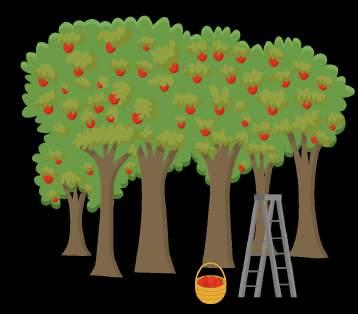





GRAPHICS BY DAMIAN GROVE & JASMINE WHITE
1. Luca Guadagnino film “Call
By Your ____”
